




By rabbi Chaim steinmetz
The following is an excerpt of the preface of Despite Everything, a collection of sermons written and edited by Rabbi Chaim Steinmetz. It will be released as a complete volume in several weeks.
At 8:15 on the morning of October 7th, there was a knock at my door. I found it strange; our building’ s staff would never bother us that early on a Saturday. Standing outside was my neighbor, with a very distressed look on his face. “There was an attack in Israel,” he said. I acknowledged the news, and was getting ready to say goodbye; a terror attack in Israel is sadly not too uncommon. Seeing my reaction, he added that “it was a bad attack.”
I paused, unsure what “bad” meant, still expecting to return to my regular pre-synagogue preparations. Then he explained that although no one yet knew the full extent of the attack, hundreds were dead. Right then, I completely stopped everything else I was doing and focused on Israel.
In a moment, everything had changed; for Israel, for the Jewish people, and for our community.
Like so many others, I was obsessed with the news, waking up in the middle of the night to check for updates. For the first few days, it was not completely clear if the State of Israel could survive if the West Bank exploded, and Hezbollah, Syria and Iran joined the attack. My heart was filled with worries and queries. What would happen to the Jewish world if Israel collapsed? What would I tell my children and my congregation if Israel disappeared? What would I tell myself?
On a daily basis, our hearts oscillated between grief, pride, hope, and every other possible emotion. It was an emotional struggle Each week, as I wrote my weekly email d’ var Torah, I brought those struggles to the words of the parsha; it was inspiring to see how familiar passages suddenly took on new meaning An obscure passage about a conflict between Isaac and the Philistines looked very different after I realized that those age-old events had taken place less than a mile from the site of the Nova Festival An unusual command about how to world’ s reaction to the attack. Timeless wisdom about life lesson The antisemitic storm unleashed by Ham recalled a medieval lesson from Rashi’ s grandson.
As the year went on, these weekly emails became a chronicle of how the Torah offers renewed enlightenment in times of crisis. They are often a snapshot of the moment they were written; my moods, our moods, would fluctuate from week to week, and the assumptions of what might happen next were constantly changing. Certain themes and ideas were repeated; other times, I changed my mind as the year went on. But together these essays create a mosaic, a unified picture of a year when spirituality was both a struggle and a strength. For that reason, they are now being published together in this book...

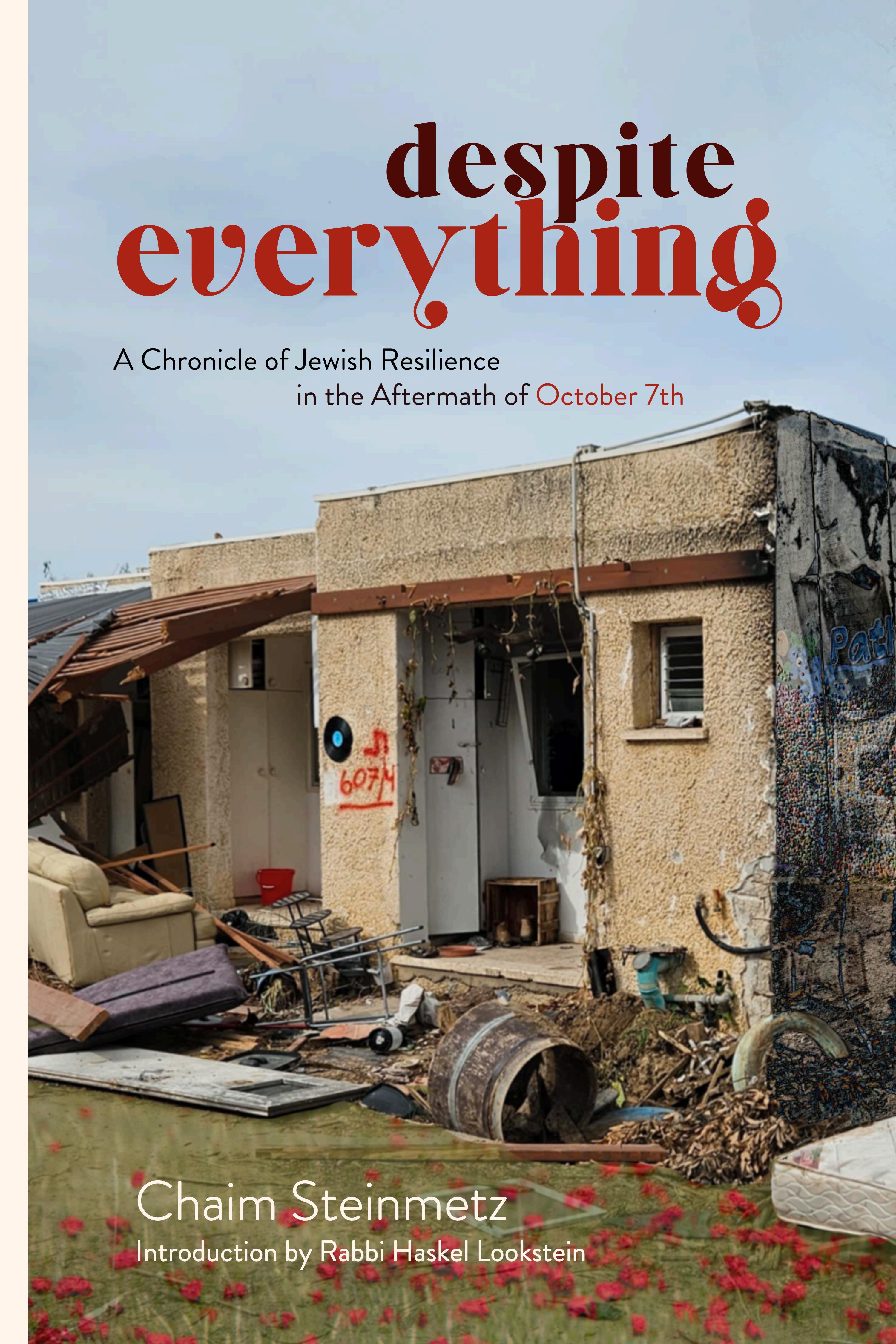
By rabbi Roy Feldman

My upbringing was steeped in Jewish tradition, but I was not fully observant growing up. It was during my freshman year at Columbia that I first encountered the profound commitment of observant Jews. That year, Yom Haatzmaut fell during midterms, a stressful time during which most students studied intensely. I campaigned vigorously among my friends to attend the Israel event at Hillel. I was crestfallen; despite my efforts, I was the only male student there who was not wearing a kippah. It was, by and large, the observant students on campus who felt that they had to show up for the campus Yom Haatzmaut event even if that meant foregoing studying that evening. They understood the sacrifice that had to be made
Yom Kippur is fundamentally about sacrifice We set aside our physical needseating, drinking, washing - to observe the day. Historically, Yom Kippur involved animal sacrifices, and our prayers continue to reflect this ancient practice, yearning for the return of such offerings.
Beyond Yom Kippur, sacrifice is a cornerstone of Judaism and our tradition. From the centrality of the binding of Isaac in the Rosh Hashanah service, to Sefer Vayikra, the book of sacrifices placed at the heart of the Torah, and the daily prayers modeled on these sacrifices, our heritage underscores the value of devotion to God. Our ancestors gave up the finest of their flocks and crops, illustrating the depth of their commitment.
As modern people, we might downplay the significance of religious sacrifice and the commitments it requires from us. To some extent, we have become accustomed to the idea that religion is there to cater to our needs rather than us devoting ourselves to God. But the centrality of sacrifices to the Torah and to Judaism emphasizes our tradition’ s priority of utter devotion to God — sometimes we must give things up.
By its nature, Halakha demands of us to make sacrifices; today’ s sacrifices are not burning animals at an altar but foregoing certain pleasures or desires. The Rav wrote in his essay Catharsis that “Halacha teaches that at every level of our total existential experience…the emotional, the intellectual, the moral-religious - one must engage in the dialectical movement by alternately advancing and retreating…Halacha encourages man to pursue greatness, vastness, to experiment daringly with his liberties… And again, Halacha will command man to halt, and to make an about-face…it teaches man how to conquer and how to lose, how to seize initiative and how to renounce, how to succeed, how to invite defeat, and how to resume the striving for victory.”


Third, whenever we give to something that is greater than ourselves we transcend ourselves by connecting with it. Think of the sacrifice Israelis make when they join the IDF. In the course of service one may be required to sacrifice health, limbs, or even life The chayalim are also postponing their productive lives, delaying their career path by several years. Serving in the IDF is a legally mandated sacrifice. Afterward, their commitment to Israel, their pride in it, their feeling of being connected to something bigger than themselves cannot be matched. And it lasts. Since October 7, countless adults have volunteered for extra reserve duty, serving in combat units and placing themselves at great risk. There is unfortunately great division in Israeli society, but what is clear is that Israelis on both sides are passionate about Israel and her soul. Both sides rally and demonstrate because they care so deeply about Israel; both sides wave the flag proudly because each person on each side is personally connected to Israel in a profound way.
Our lives cannot be meaningful and our people will not endure and our relationship with God cannot thrive and we cannot live together as a community without sacrifice. What I found inspiring about my peers who joined the Yom Ha’atzmaut event despite the impending midterms was that they knew that they were part of something greater, part of the Jewish people, and that meant that spending the evening studying had to be sacrificed. It was then I decided I must explore Orthodox Judaism further and I took some steps to do that. This was a community that took their Jewishness seriously. Not just Yom Ha’atzmaut but every day they ate in the kosher section and each week they observed Shabbat, they said “there is something that is more important to us than ourselves.” They knew they were, in Rabbi Jonathan Sack’ s words, “letters in the scroll.” “I am a Jew,” Rabbi Sacks wrote, “because only if I remain a Jew will the story of a hundred generations live on in me I continue their journey because, having come this far, I may not let it and them fail. I cannot be the missing letter in the scroll.”
The successful Jewish family is a family that makes sacrifices for the values it holds dear; Choosing to live thickly Jewish lives despite all the inconveniences, expenses and challenges. And in all three ways we have discussed here, sacrifice makes for a meaningful Jewish life. One: When we make sacrifices for God and Judaism, when we actually give things up for those values, we come to love God more and we come to love our Judaism more. And the members of our community will love each other more. Two: When we make those sacrifices, we reveal our true authentic selves, what our primary values are; not just our ephemeral wants, not just what gives us instant gratification but what we actually believe in perennially And three: By making these sacrifices, we connect instantly yet profoundly to God, Israel, and thousands of years of Jews before us Making sure we know what our values are and where we stand is more important now than it ever has been.
Let us resolve these High Holy Days to put our money where our mouth is: to identify what we believe in, and commit ourselves to those values not just in speech but in action.
OUR RELATI ONSHI P WE CANNOT



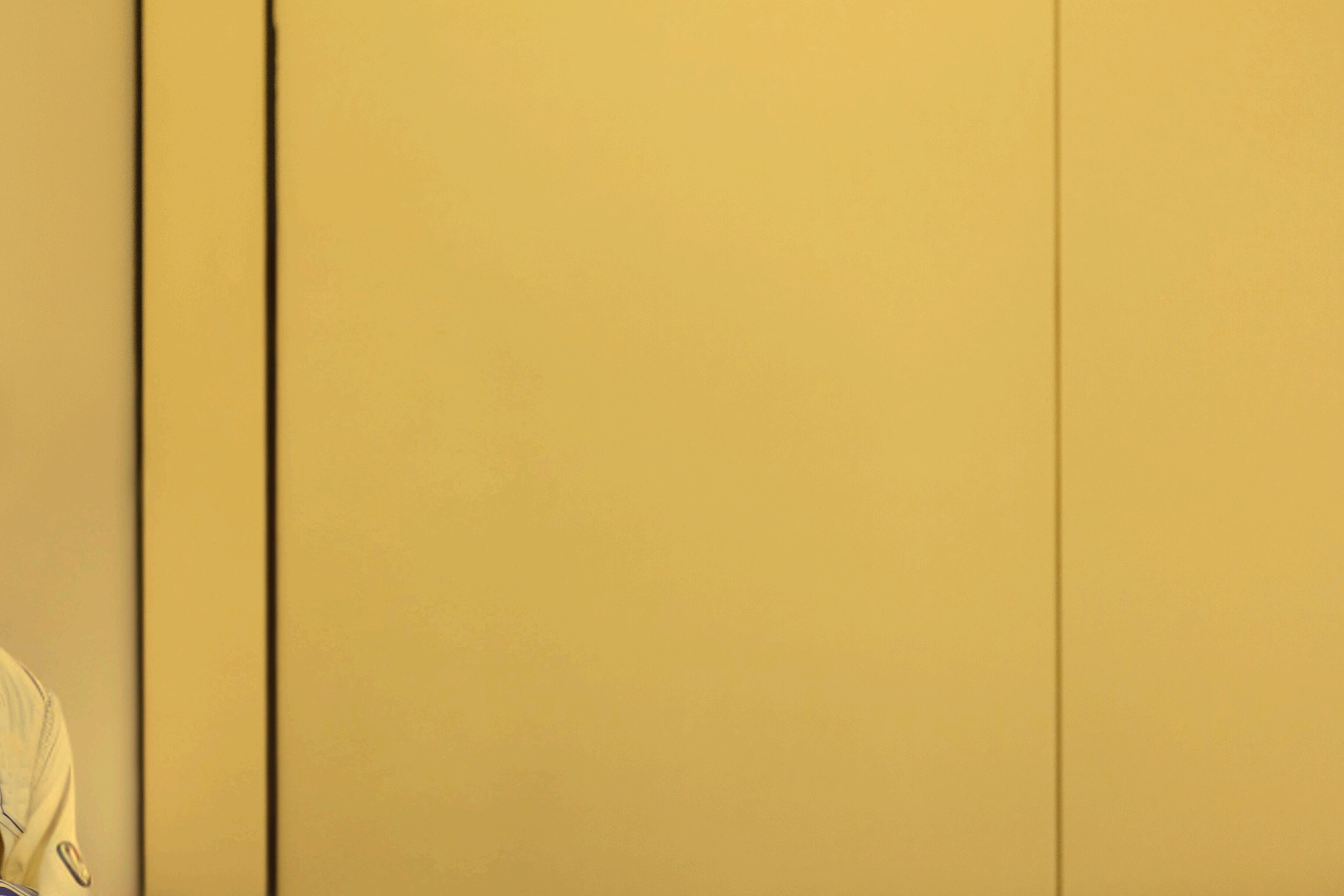

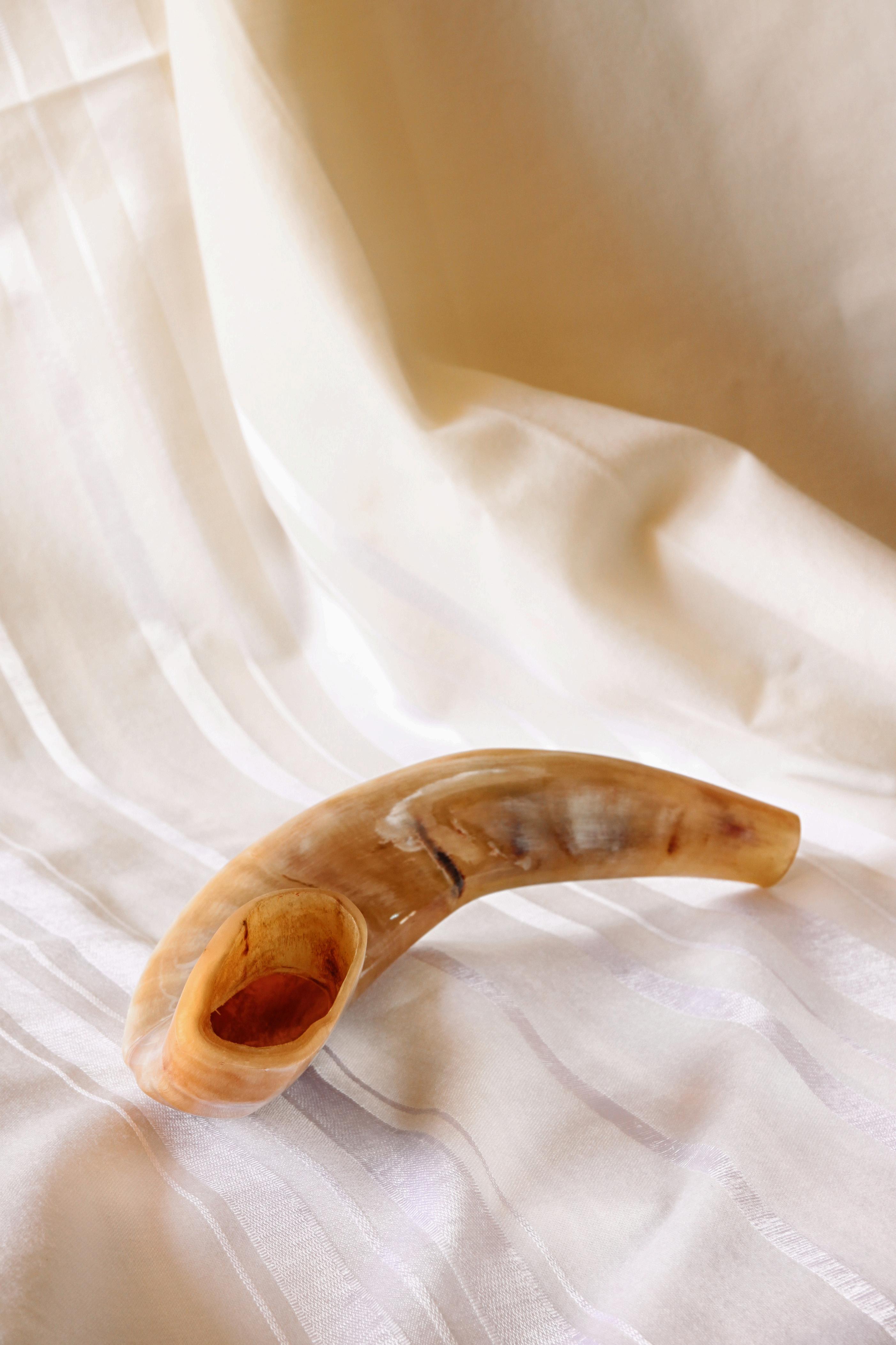
By Rabbi meyer laniado
The shrill of the shofar sends shivers down my spine. I feel goosebumps and am overcome with a sense of awe. In my mind' s eye, I am facing the city of Jericho as its walls come crashing down. I am with Abraham as he embraces his son, spared from sacrifice. I am at Sinai, trembling before the thunder, lightning, and the shofar’ s overpowering blast, overwhelmed by God’ s presence. Yet, it is not the blast that lingers but the silence that follows that really moves me
As the shofar’ s final note fades, the room is enveloped in an almost palpable silence, as if the air itself has become heavy with meaning. Every breath is held, every rustle ceases, and the space between us expands. In this quiet, each person is left alone with their innermost thoughts. It is at this moment that my chest and my stomach tighten with nervousness and anticipation for a moment where we confront ourselves and stand in the presence of our Creator.
This is profoundly expressed in the powerful 6th-century piyut, which has become the quintessential prayer of every Ashkenazi synagogue on Rosh Hashanah, Untane Tokef.
It reads: uBshofar Gadol Yitaqa, veQol Demamah Yishama. A Great Shofar Shall Be Blown, and a Small, Still Voice Shall Be Heard.
The piyut states that ‘ a great shofar shall be blasted,’ yet, surprisingly, it is not the resounding, reverberating shrill of the shofar that is heard. As the piyut continues, it is a ‘Qol Demamah, ’ a small, still voice that emerges
This small, still voice, or Qol Demamah, from Untane Tokef mirrors the unique phrase Qol Demamah Daqah that appears in Eliyahu' s contest at Har haCarmel. There, after confronting the 450 false prophets of Ba’al, Eliyahu haNabi encountered God in a profound silence, a Qol Demamah Daqah.
Despite his momentary success in proving these prophets false, incapable of bringing forth fire from heaven, Eliyahu remained immensely frustrated. He failed to convince the nation and their Queen, Izebel, to move away from the worship of Ba’al. In fact, Izebel was enraged and sought to take Eliyahu’ s life in revenge for his killing of the false prophets of Ba’al. In his despair, Eliyahu ran to the wilderness, where he walked forty days and forty nights, finding himself at the same mountain where Benei Yisrael had encountered God amidst thunder, lightning, fire, and the blast of the Shofar (Melakhim 1 19).
We often imagine God’ s voice as overpowering and earth-shattering, yet in Eliyahu' s encounter, we learn that God' s voice was not in the mighty wind, the earthquake, or the fire but in the small, still voice, the Qol Demamah Daqah Rashi interestingly comments on this phrase, expressing that “ no voice was actually heard (Melakhim 1 19:11). ” Rather, it was a perception of something profound emerging from the silence.
Daniel Matt, in his book Becoming Elijah, expands on our understanding of Qol Demamah Daqah and translates it not merely as a small voice but as a 'pregnant, vibrant silence'—a stillness so profound it carries the weight of the Divine Presence. This silence is not an absence but a presence—an experiential stillness through which Eliyahu perceives God (Becoming Elijah, page 29)
Benei Yisrael, like Eliyahu, also experienced ‘hearing’ God’ s voice on this same mountain The Midrash Shemot Rabbah describes the moments leading up to revelation:"No birds were chirping, no oxen were plowing, none of the Ophanim (angels) said 'Kadosh,' the sea did not roar, none of the creatures made a sound”—Ele haOlam Shotek uMaharish veYasa haKol: Anokhi Hashem Elohekha, but rather, “the entire world was quiet and silent. Then, from this thick silence, the voice emerged and said:'I am the Lord your God'"(Shemot Rabbah 29:9).
The world was entirely silent—complete stillness—and from this silence, Eliyahu and Benei Yisrael experienced the voice of God. In this absolute quietude, the Divine voice emerged, not from the shofar' s sound but from the stillness and silence—the holding of breath—the refrain from all creation
In the book The Chosen, Chaim Potok captures the potency of this type of silence as he writes:"I' ve begun to realize that you can listen to silence and learn from it. It has a quality and a dimension all its own. It talks to me sometimes. I feel myself alive in it. It talks. And I can hear it (page 225). ”
This idea is echoed by Gordon Hempton, an Emmy-winning acoustic ecologist known for capturing the world' s natural soundscapes: “Silence is not the absence of something but the presence of everything… But silence cannot be imagined, although most people think so. To experience the soul-swelling wonder of silence, you must hear it (One Square Inch of Silence: One Man' s Search for Natural Silence in a Noisy World, prologue page 2). ”
To ‘hear it,’ we need to listen actively. Yet, so many seem to avoid this experience. At moments of quietude, we pick up a book, read an article, listen to a podcast, or take on an activity to fill the void and ‘be productive.’
Blaise Pascal, the 17th-century philosopher and mathematician, observed that even a king, surrounded by wealth and power, is not immune to this need for distraction. In his Pensées, he writes that [this king] “If he is without what is called entertainment, he is unhappy, and more unhappy than the least of his subjects, who plays and entertains himself” (Pensées, Fragment 139).
Pascal harshly criticized humanity’ s obsession with what he called divertissement—the relentless pursuit of entertainment and distraction, which he saw as an escape from the discomfort of facing one ' s mortality and the profound truths of existence. He argued that "all of humanity' s problems stem from man ' s inability to sit quietly in a room alone." This restlessness, Pascal suggested, leads people to seek diversions that can manifest in harmful ways, such as the pursuit of war, driven by a desire to avoid confronting the uncomfortable realities of life and oneself.
In a 2014 study, Pascal' s observations were corroborated in a paper entitled Just Think: The Challenges of the Disengaged Mind, in which Dr Erin Westgate shared her findings that 67% of the men in her study preferred to self-administer electric shocks rather than sit quietly with their thoughts for fifteen minutes.
Many years ago, I took a group of campers to the Grand Canyon. Instead of standing in awe and soaking in the vastness, they immediately took out Nintendo Game Boys and playing cards—the thought of experiencing the void' s stillness, quietude, and expanse was viewed as strange and something to be avoided. They may not have been afraid or uncomfortable with silence but unaccustomed to stillness and quietude—habituated to filling the void.
Rosh Hashanah urges us to embrace stillness, confront our innermost thoughts, and stand face-to-face with our Creator.
As the shofar' s sound pierces the air, it calls us to attention and invites us to immerse ourselves in the vibrant silence that follows This silence is not void but a resonant stillness, stripping away distractions and compelling us to confront our innermost selves before God.
When the shofar’ s blast fades, a momentary stillness permeates the room. In that silence, we hold our breath, drawn into a moment of reflection and introspection. Everything stops as we stand together during Mousaf, and our minds briefly pause from their perpetual chaos We focus, feeling the room filled with this tangible stillness It is the steady calm that emerges when all distractions fade, the moment where the noise of life subsides, and we are left with the unmistakable presence of something greater.
The Mishna captures this intimate moment, describing how we stand kibnei Maron—each of us individually, personally, standing before God, fully exposed to the reality of our existence and the truth of who we are (Mishnah Rosh Hashanah 1:2).
This Rosh Hashanah, let us not merely hear the shofar’ s blast but embrace the silence that follows In that sacred stillness, may we find clarity, reflect deeply on the year past and the one to come, and discover a renewed connection with ourselves and our Creator.
For Qol Demamah is not just a still, small voice—it is the profound quiet that allows us to truly listen. In this silence, we find the space to confront our deepest thoughts and the strength to stand before our Creator with honesty and humility
In this we find the space to confront our deepest thoughts . . . SILENCE



By Max hollander
On the eighth day you shall hold a solemn gathering; you shall not work at your occupations You shall present a burnt offering, an offering by fire of pleasing odor to God; one bull, one ram, seven yearling lambs, without blemish The meal offerings and libations for the bull, the ram, and the lambs, in the quantities prescribed, and one goat for a sin offering—in addition to the regular burnt offering, its meal offering and libation.
The last day of Yom Tov is called "Simchat Torah" because we rejoice on it, making a festive meal in honor of the finishing of the Torah It is customary for the person who finishes the Torah and the one who starts Genesis to make a donation and invite everybody to a party (Tur) It is customary in these countries to take all of the Torahs out of the Ark on Simchat Torah at night and in the morning and to sing songs and praises.
(Shulchan Arukh, Orach Chayim 669:1)
of the yearly hall observe a athering: you work at your pleasing odor meal offerings escribed, and ing, its meal ven then the s of Shemini e substantial cted holiday d on Shemini e mitzvot to Mishkan, and hat Torah has eral medieval 14th-century mmarizes the on it, making or the person ion and invite of the Torahs ng songs and oms that we customs.
This is tragic. It is tragic because — while Simchat Torah is certainly a beautiful holiday in its own right and an occasion worth celebrating — in many shuls it comes at the cost of the powerful religious and communal experience Shemini Atzeret can offer.
Rabbinic tradition attempts to describe the nature of Shemini Atzeret with two different parables. The first parable appears in Masechet Sukkah:
“Rabbi Elazar said: These seventy bulls [that are sacrificed as additional offerings over the seven days of Sukkot]. To what do they correspond? They correspond to the seventy nations [and are brought to atone for their sins and to hasten world peace.] Why is a single bull [sacrificed on the Eighth Day of Assembly?] It corresponds to the singular nation, Israel A parable: A king of flesh and blood who said to his servants: Prepare me a great feast. On the last day, he said to his beloved servant: Prepare me a small feast so that I can derive pleasure from you [alone]. ” (Sukkah 55b)
Rabbi Elazar said: These seventy bulls [that are sacrificed as additional offerings over the seven days of Sukkot]. To what do they correspond? They correspond to the seventy nations [and are brought to atone for their sins and to hasten world peace ] Why is a single bull [sacrificed on the Eighth Day of Assembly?] It corresponds to the singular nation, Israel A parable: A king of flesh and blood who said to his servants: Prepare me a great feast. On the last day, he said to his beloved servant: Prepare me a small feast so that I can derive pleasure from you [alone]. (Sukkah 55b)
This Gemara serves as the basis for the theory of Shemini Atzeret by many great commentators, including the Esh Kodesh, the Zohar, the Midrash Tanchuma, and Rashi. It is used to define Shemini Atzeret as a time of intimacy with God. This intimacy comes after seven long days of Sukkot full of sacrifices which, according to this Gemara, are made on behalf of the other nations of the world.
Shemini Atzeret is our chance to have a more exclusive celebration with God In Rashi’ s comments on the Gemara above, he writes: “I (God) don’t benefit or relax from theirs [sacrifices about them], but rather yours [sacrifices about you.]”
However, in the holiday’ s description in Vayikra, the Chizkuni inserts a different parable from the one in Masechet Sukkah. This parable lends a different atmosphere to Shemini Atzeret that can impact how we should embrace and celebrate this holiday.
““It is a day of special assembly;” this is a parable describing a king whose children came to visit him for the first time; at that time the king said to them: “When are you going to visit me again?” they said to him: “in about a couple of months. ”Thereupon the king took his leave of them. When the children came again to see their father the king, he asked again when they would come to see him again. When they said that they would come again in about four months, the king again thanked them for their visit and bid them farewell. When this story repeated itself a third time and on that occasion the children told him that they would not visit him again until after about seven months, the king begged them to delay their departure for at least one additional day. They agreed and did so. He gave them a special blessing for having spent the extra time with him.”
“It is a day of special assembly;” this is a parable describing a king whose children came to visit him for the first time; at that time the king said to them: “When are you going to visit me again?” they said to him: “in about a couple of months ”Thereupon the king took his leave of them. When the children came again to see their father the king, he asked again when they would come to see him again. When they said that they would come again in about four months, the king again thanked them for their visit and bid them farewell When this story repeated itself a third time and on that occasion the children told him that they would not visit him again until after about seven months, the king begged them to delay their departure for at least one additional day. They agreed and did so. He gave them a special blessing for having spent the extra time with him.
Reading these parables side-by-side, there is a tangible difference in the atmospheres they describe The former paints Shemini Atzeret as an extension of an ongoing party with a more exclusive guest list, while the latter isn’t a party at all.
The latter source captures an emotional moment of muted longing by God who is unable to bid the Jewish people, His children, farewell. In this parable, God begs us to spend one more day with Him in Jerusalem. Other versions of this parable more powerfully imagine God as saying “Children, I beg of you, stay one day more with me; it is so hard for me to part from you!”
The second parable offers a very powerful insight into the atmosphere that may have permeated Shemini Atzeret before the advent of Simchat Torah; the insight was subsequently lost in the chaos of Simchat Torah.
One may argue — and many have — that our collective celebration of the Torah is how we have chosen to express our love for God. But I don’t interpret the emotional experience presented by the second parable as one of levity and dancing customary on Simchat Torah. Throughout Tanach, the word “Atzeret” is often translated as a solemn assembly, an atmosphere of thoughtfulness and emotional intensity. We might liken Shemini Atzeret to a goodbye hug that lasts a few seconds longer than normal — a hug that lingers, not because we don’t know when to let go but because we don’t want to
Shemini Atzeret stands at the end of a long period of intense togetherness and the beginning of a distance between the Jewish people and God, who would not be “together” again until Pesach. This parable encourages us to recognize that distance and cleave to God. In Rabbi Samson Raphael Hirsch’ s commentary on the Torah, he describes the deeper significance of Shemini Atzeret: “On the eighth day, the sounds of the public rejoicing of the Sukkot festival cease. No Longer do we contemplate in a state of rapture the distant future of all mankind’ s salvation. Rather, we quietly assemble before God before we return to the reality of the still unrefined, imperfect present. Only then can we return to the service of God of everyday life, for our consciousness has been enriched and elevated by the whole cycle of the festivals, and the spirit that inspired us when we were before God will not depart from us in all the trials that we are likely to face.
On the eighth day, the sounds of the public rejoicing of the Sukkot festival cease. No longer do we contemplate in a state of rapture the distant future of all mankind’ s salvation. Rather, we quietly assemble before God before we return to the reality of the still unrefined, imperfect present. Only then can we return to the service of God of everyday life, for our consciousness has been enriched and elevated by the whole cycle of the festivals, and the spirit that inspired us when we were before God will not depart from us in all the trials that we are likely to face.
On this eighth day, we renew, at the parting greeting in God’ s Sanctuary, the consciousness that all of us together belong to God and are bound in our destinies and endeavors to His Torah. As one community we shall work in the fields of the future of humanity; as one community we shall be guides leading the flock of nations; and God’ s guidance will be revealed through our destiny, for we are His covenantal people… ” (Rabbi Samson Raphael Hirsch on BaMidbar 29:35-38)
On this eighth day, we renew, at the parting greeting in God’ s Sanctuary, the consciousness that all of us together belong to God and are bound in our destinies and endeavors to His Torah. As one community we shall work in the fields of the future of humanity; as one community we shall be guides leading the flock of nations; and God’ s guidance will be revealed through our destiny, for we are His covenantal people… (Rabbi Samson Raphael Hirsch on BaMidbar 29:35-38)
There is an intensity to this version of Shemini Atzeret that we must remember as we celebrate Simchat Torah. And at the end of Sukkot, we might relate to God’ s sense of premature longing for the people in our lives who have come home for the holidays — relatives, extended family, grandparents, children — and are not normally with us. Shemini Atzeret is an opportunity to treasure these loved ones and have one more day with them, free from the distractions of prolonged ritual obligations and mitzvot. Shemini Atzeret also offers those who recite Yizkor a chance to contemplate the memory of the departed with an intensity that is usually difficult to access
This vision of Shemini Atzeret should not be lost in the balagan of Simchat Torah. When we love someone, we should not miss the opportunity for a proper goodbye, holding our loved ones quietly and thoughtfully, for just a bit longer.
The holding might make saying goodbye more bitter — but it makes seeing them again that much sweeter.

By ruthie hollander
The following remarks were shared on Shabbat Kalaniyot, a unity Shabbat where our community dedicated a painting of 1200 kalaniyot flowers made by the children of KJ. The kalanit is an indigenous flower that grows in the areas besieged on October 7th, and it has become a symbol for the people and communities that were viciously attacked.
Shabbat Shalom, and thank you for allowing me to bring our kids — and the future of the Jewish people — up here today.
The purpose of Shabbat Kalaniyot is to celebrate the lives of the people who were killed on October 7th, not only to commemorate their deaths.
It is so easy to get lost in the tragedy and pain of that day. But I never want to forget the beauty of who these people were before October 7th. The people they loved; the lives they touched; the land they nurtured; their values, hopes, and dreams. They were beautiful long before October 7th. They are more than who they were on October 7th.
The Jewish people are more than who we were on October 7th. Because both before and after October 7th, we have always been a nation of strength, character, generosity, faith, and hope. And we will continue to be. We are a people that celebrates life.
Over the past week, we have painted 1200 flowers on a canvas These flowers were painted by our children with great care and attention. And I watched their small faces, concentrated, focused, nervous They wanted their flower to be beautiful They wanted to do it right
Already, our children are learning to celebrate life And they have captured that in these 1200 flowers.
Our future is bright.
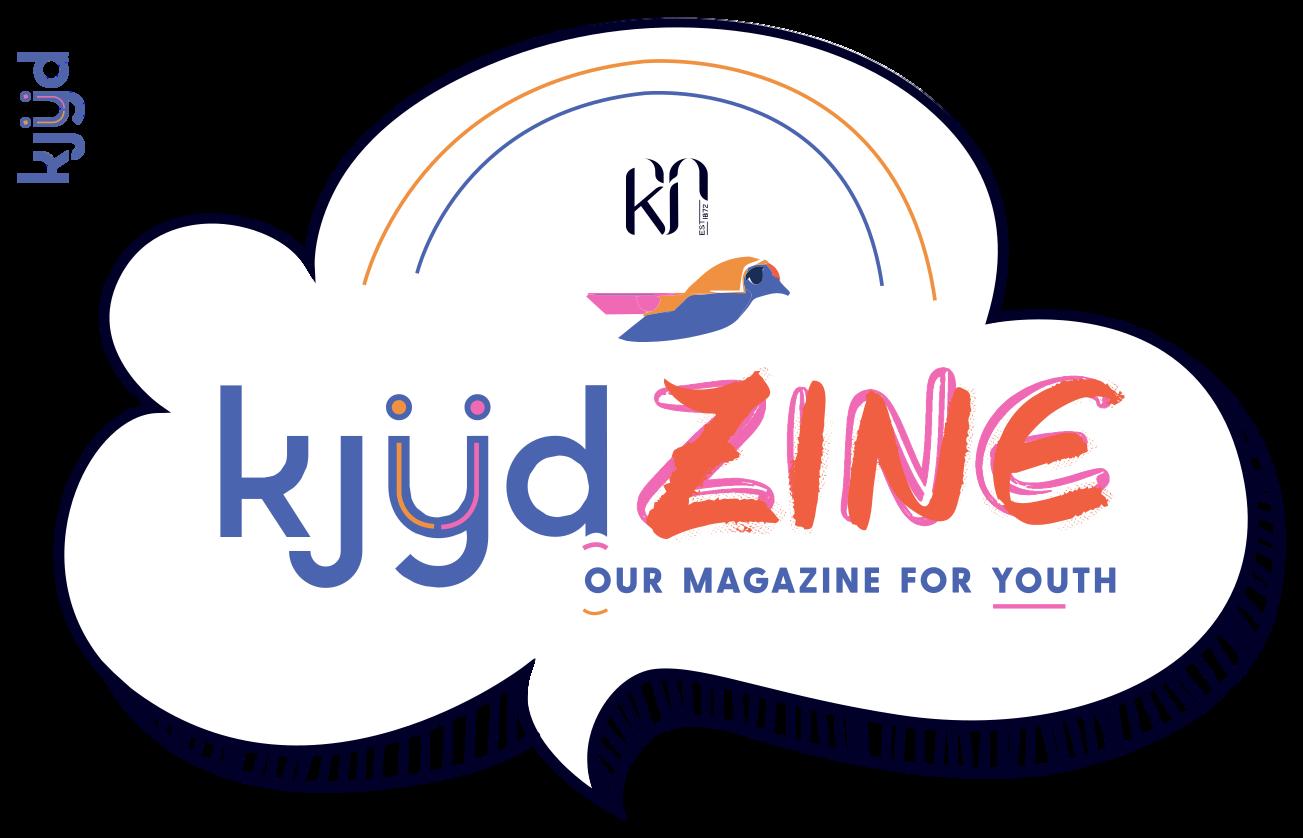

YoucanmakeRosh Hashanahspecialby dippingtheapplein thehoney,whenthe ballerinascome,by havingdanceparties andgum,andby havingalotofthings todo.
JeriKatz,age3
YoucanmakeRoshHashanah specialbycallingyourfamilyand wishingthemahappynewyearand byeatingapplesdippedinhoney becauseitishealthyandsweet,like howwewantouryeartobe JoshFromm,age7
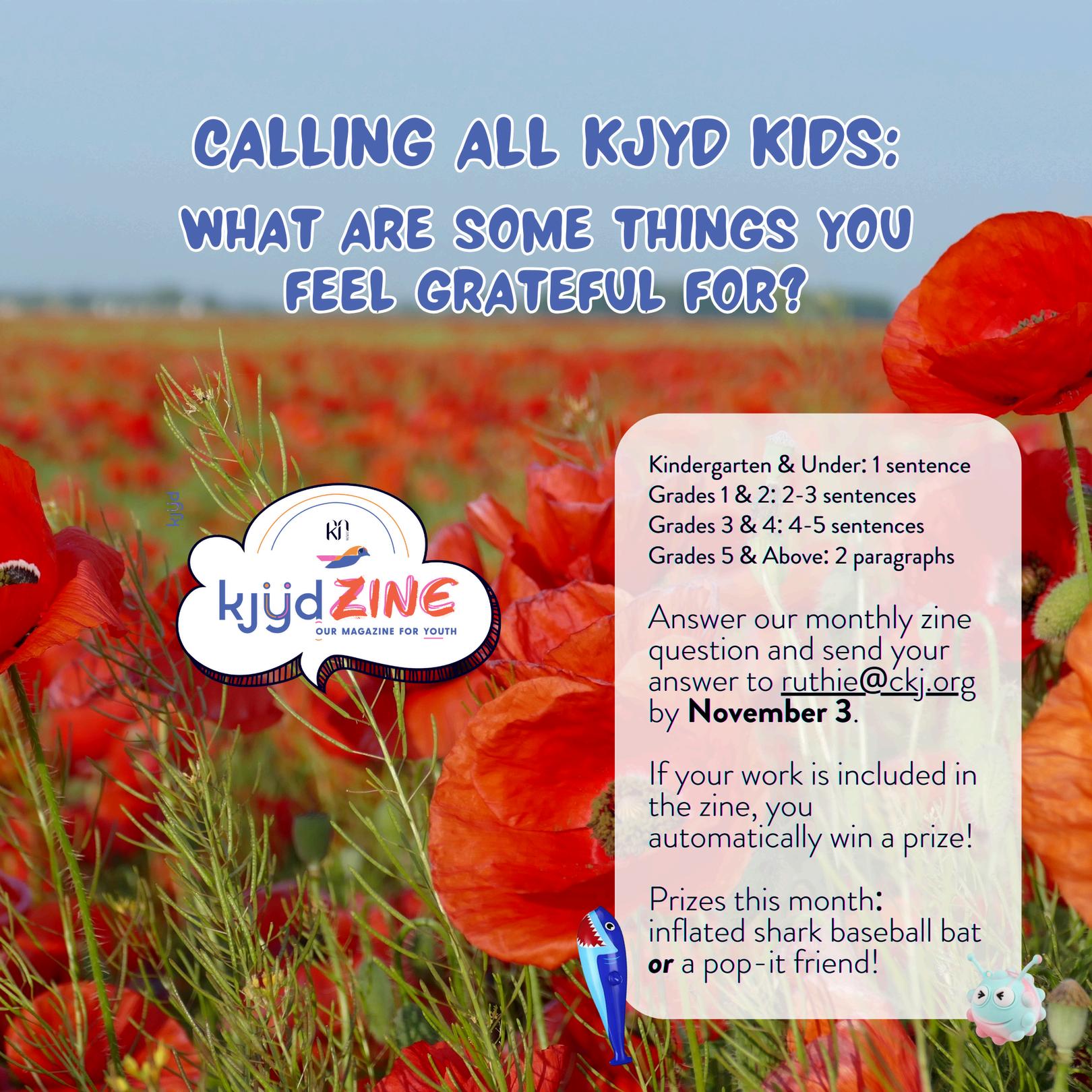
YoucanmakeRosh Hashanahspecialby spendingtheholidaywith yourfamily,givingtzedakah, andgoingtoshul GoldieFromm,age5
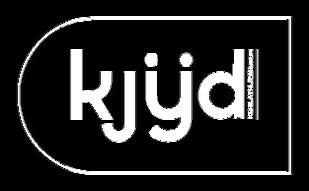


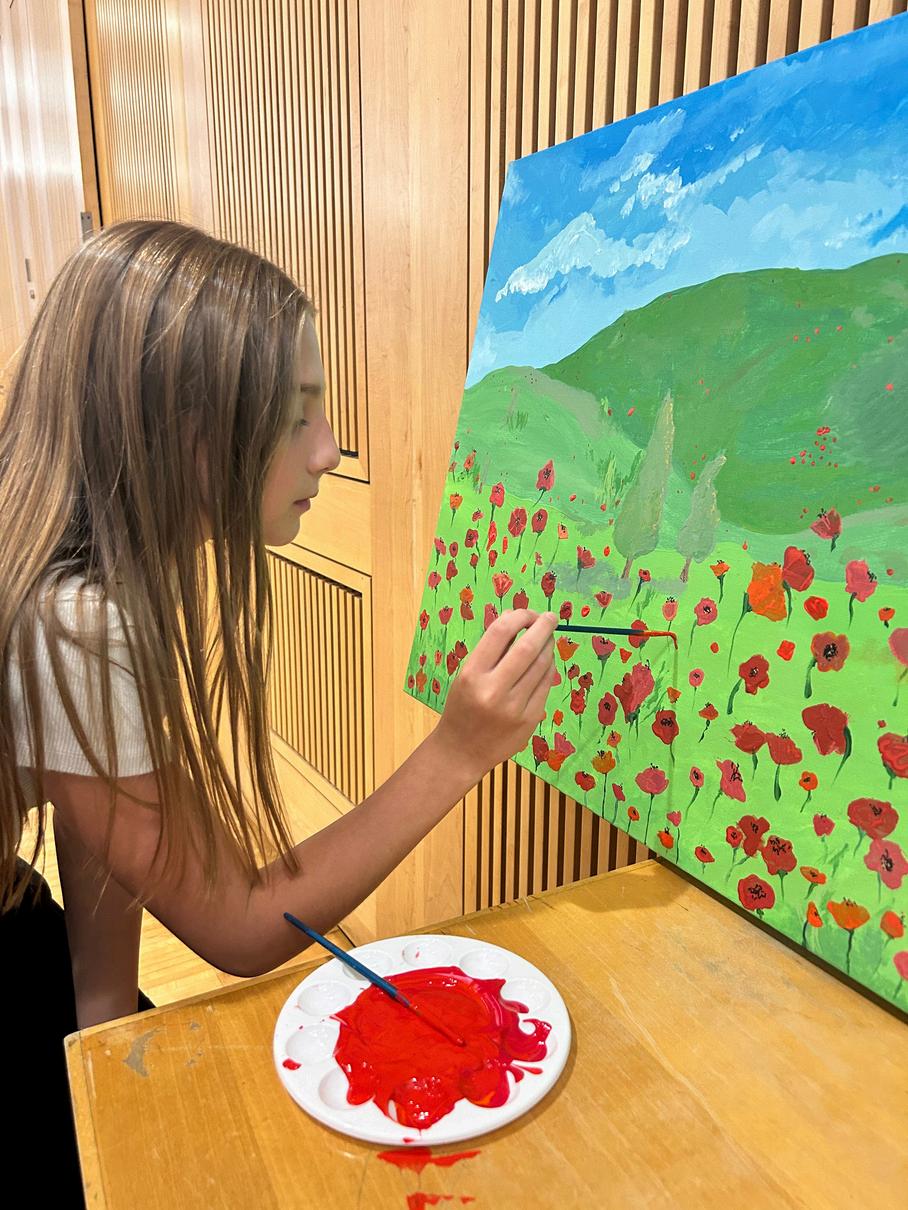


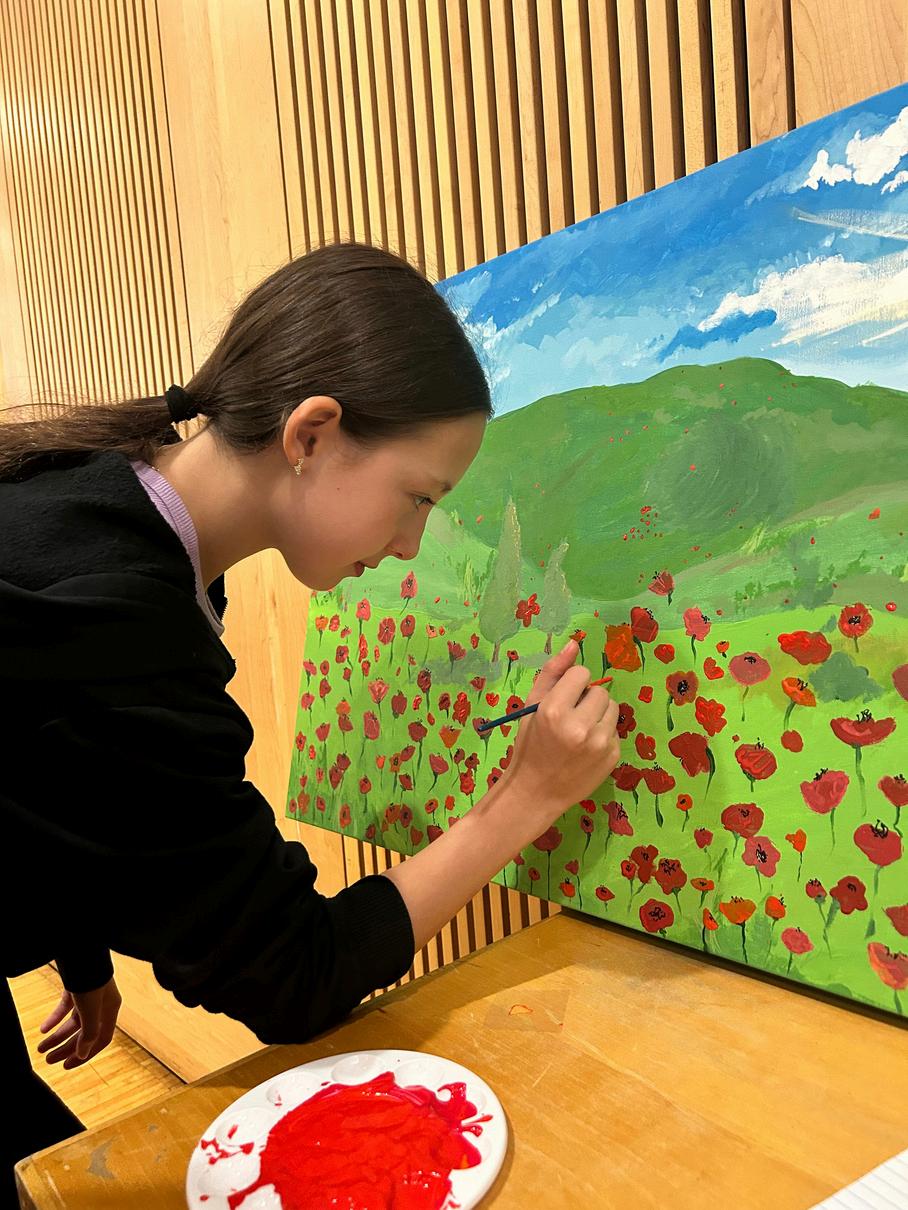


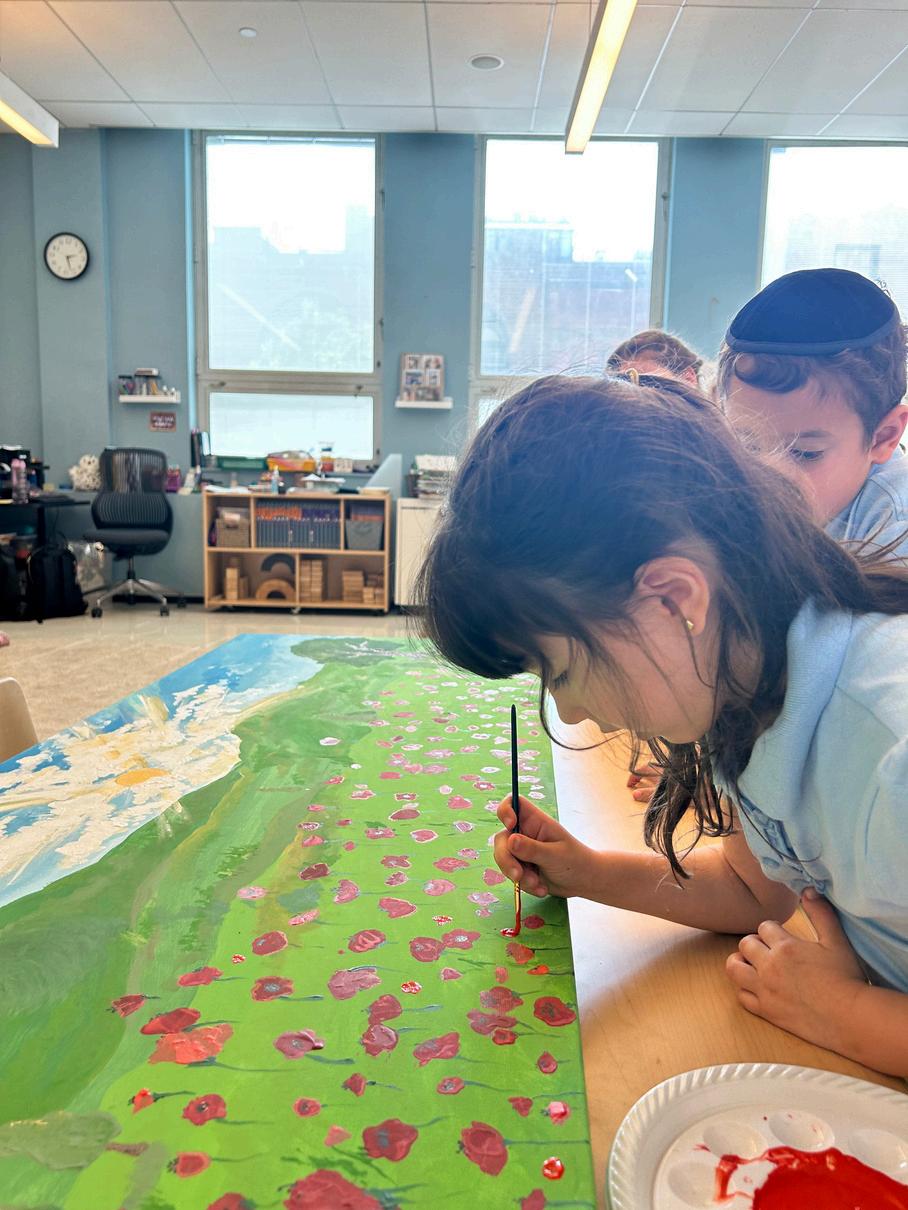
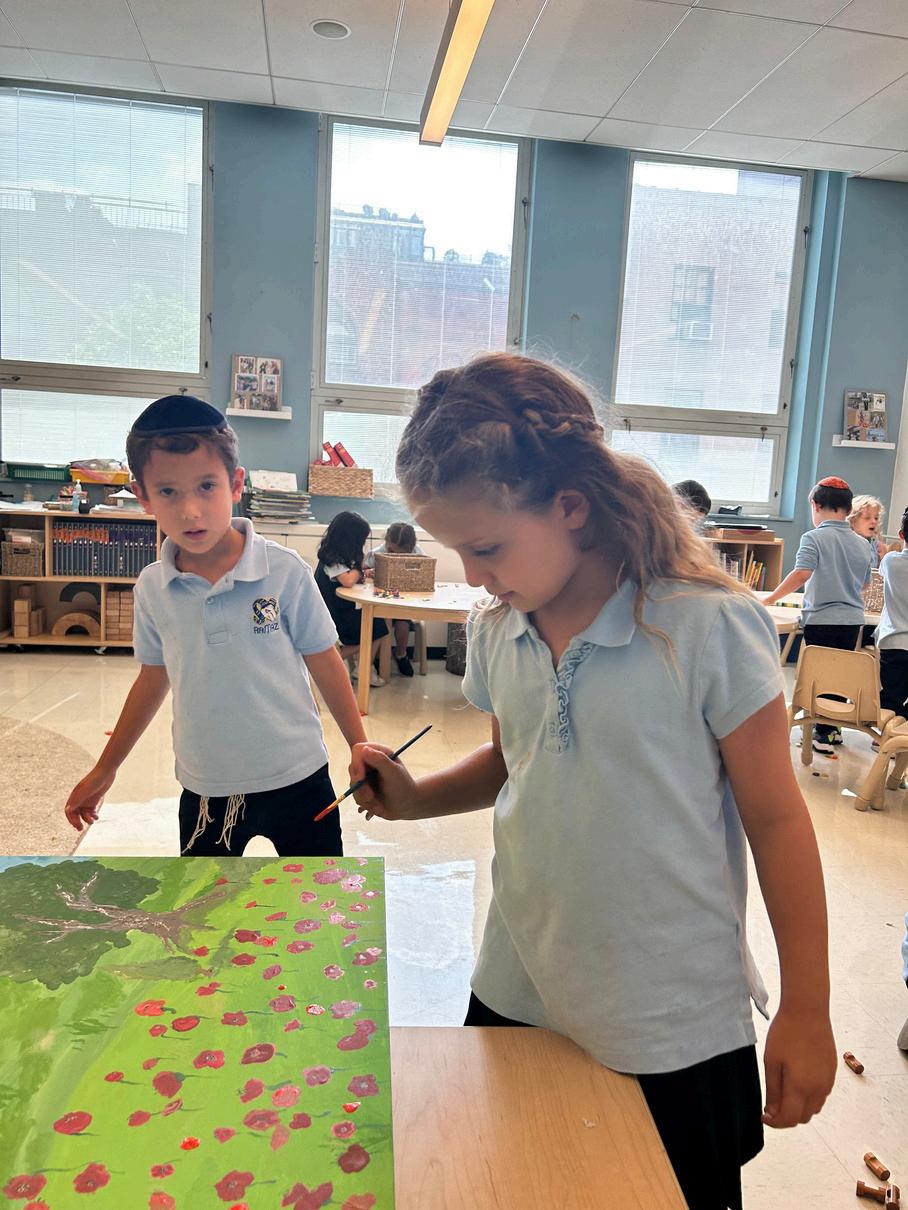
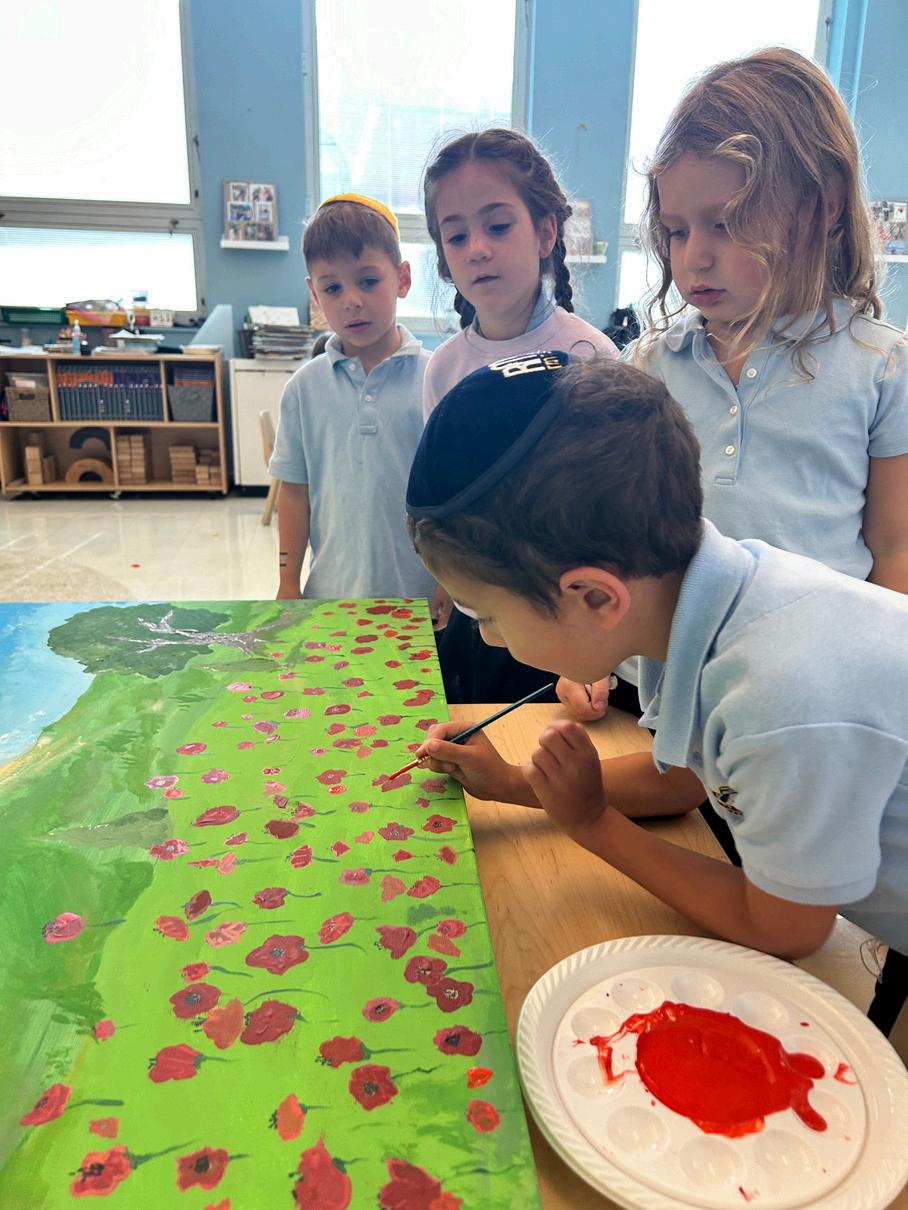
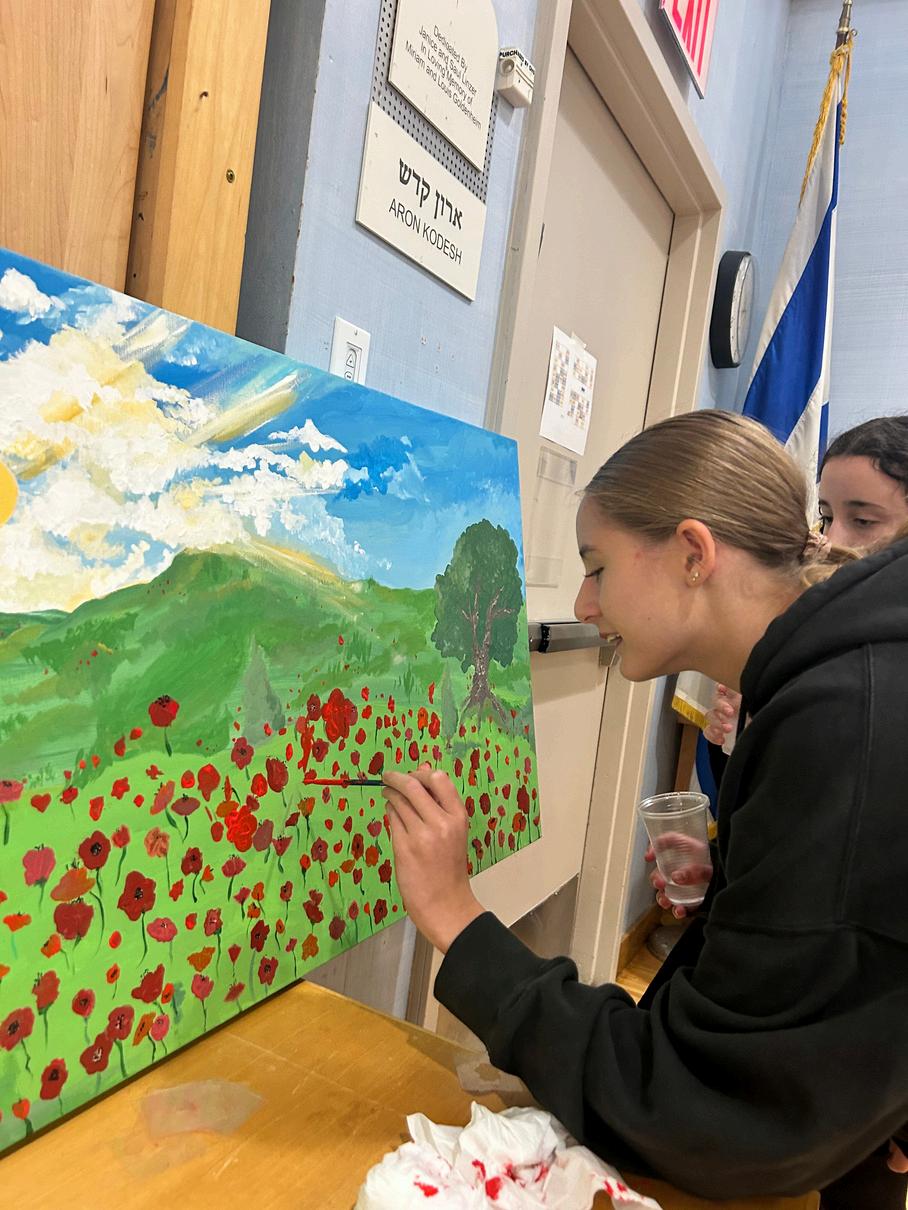

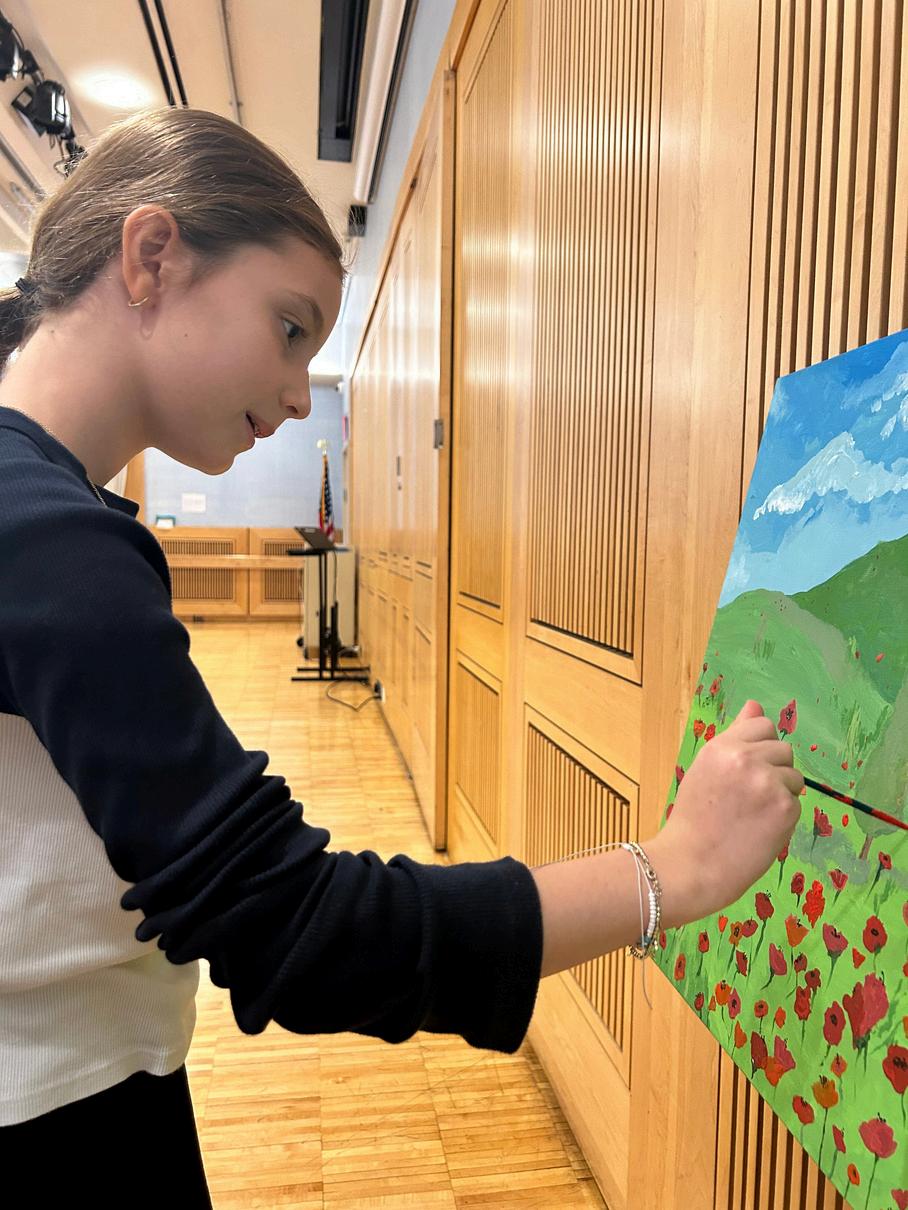


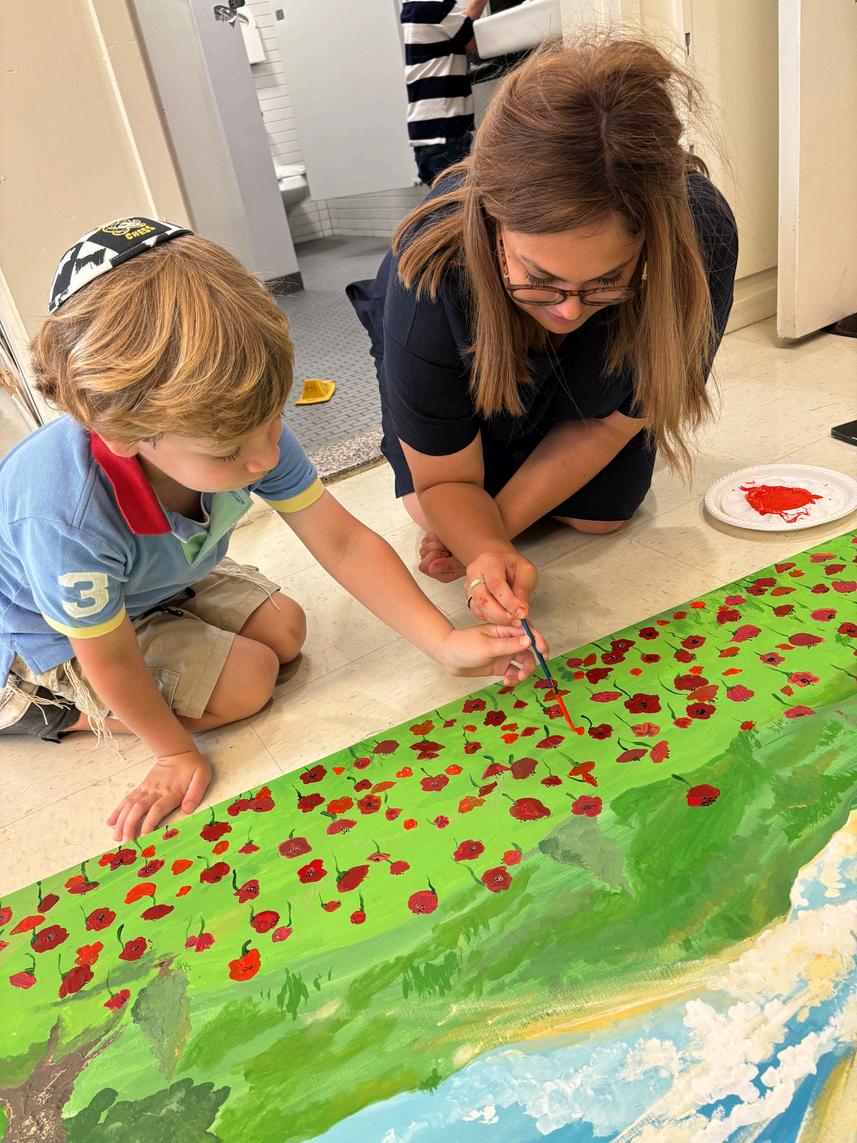




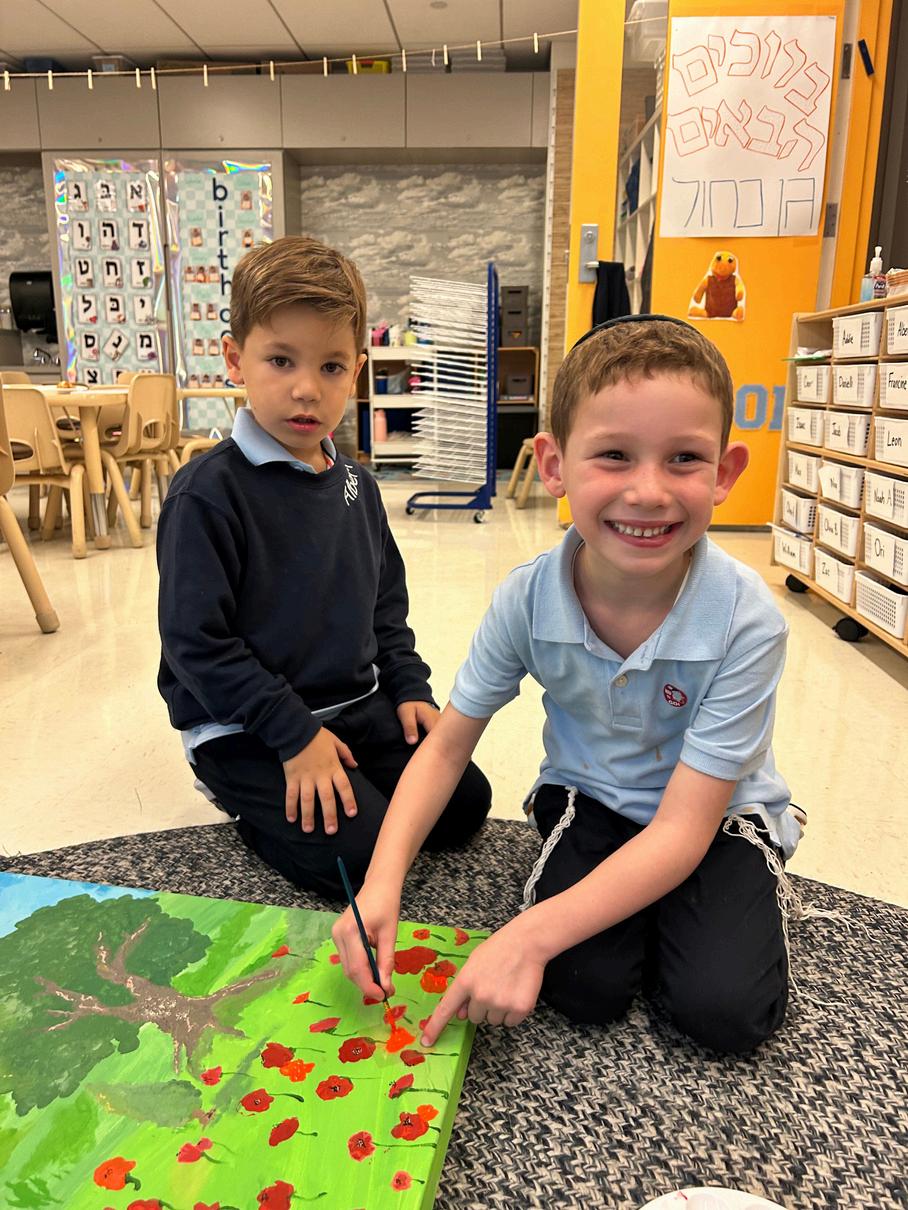



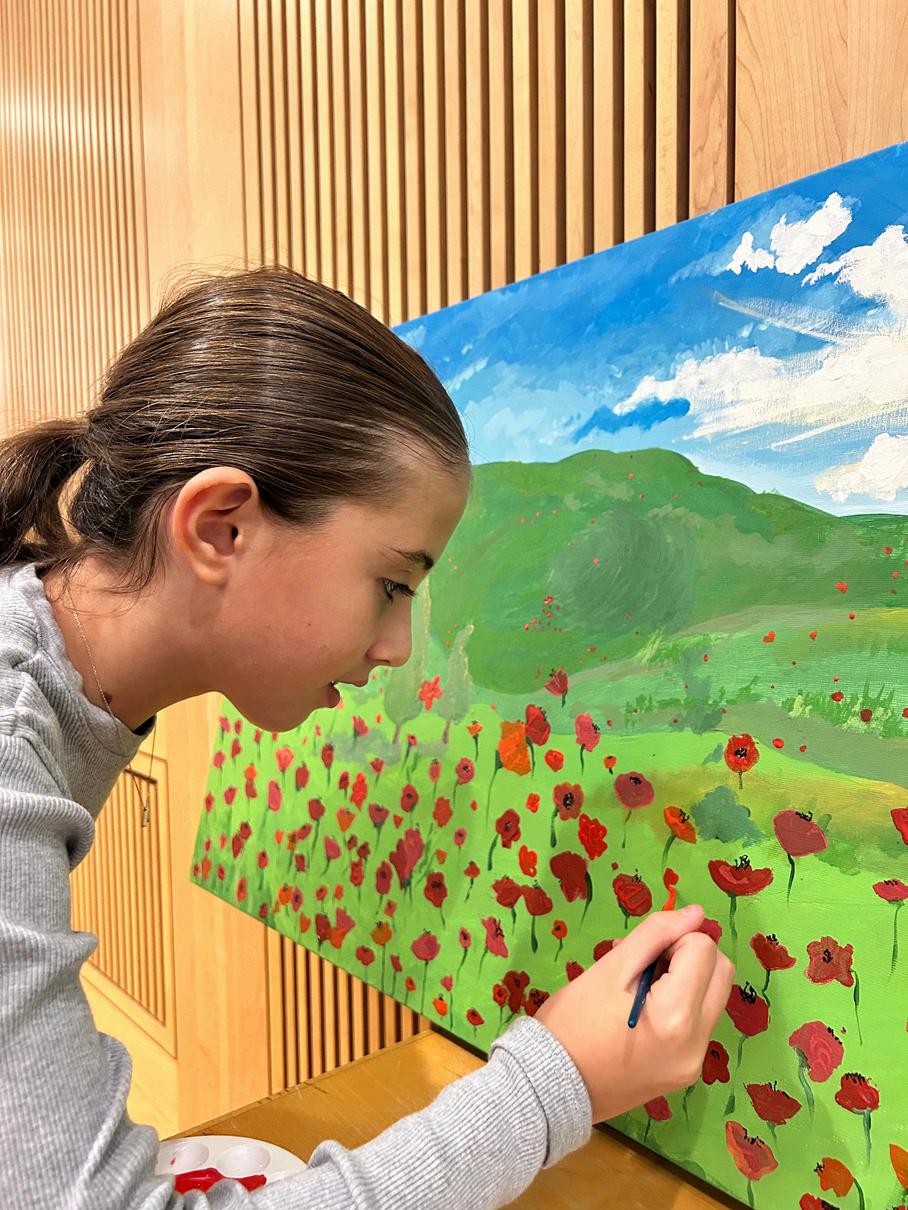



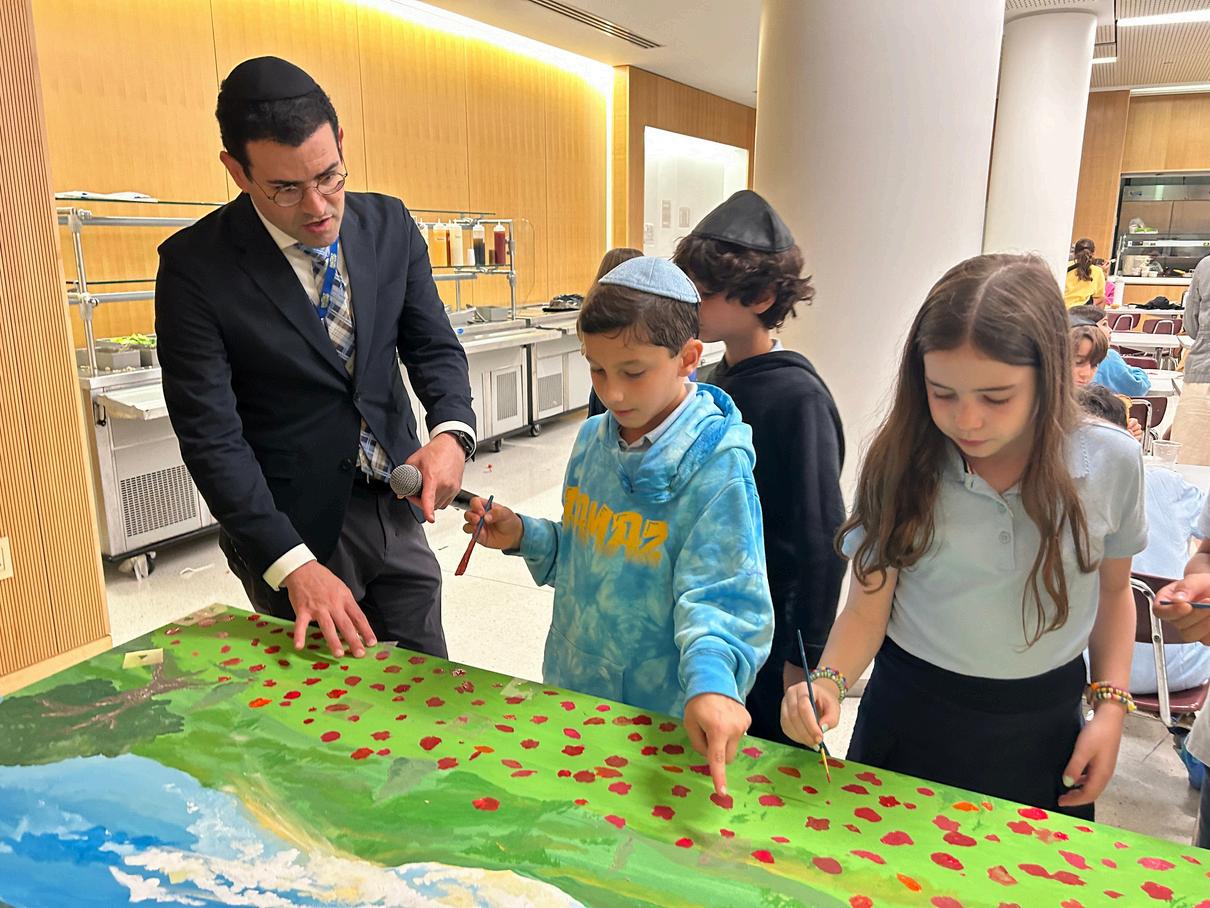


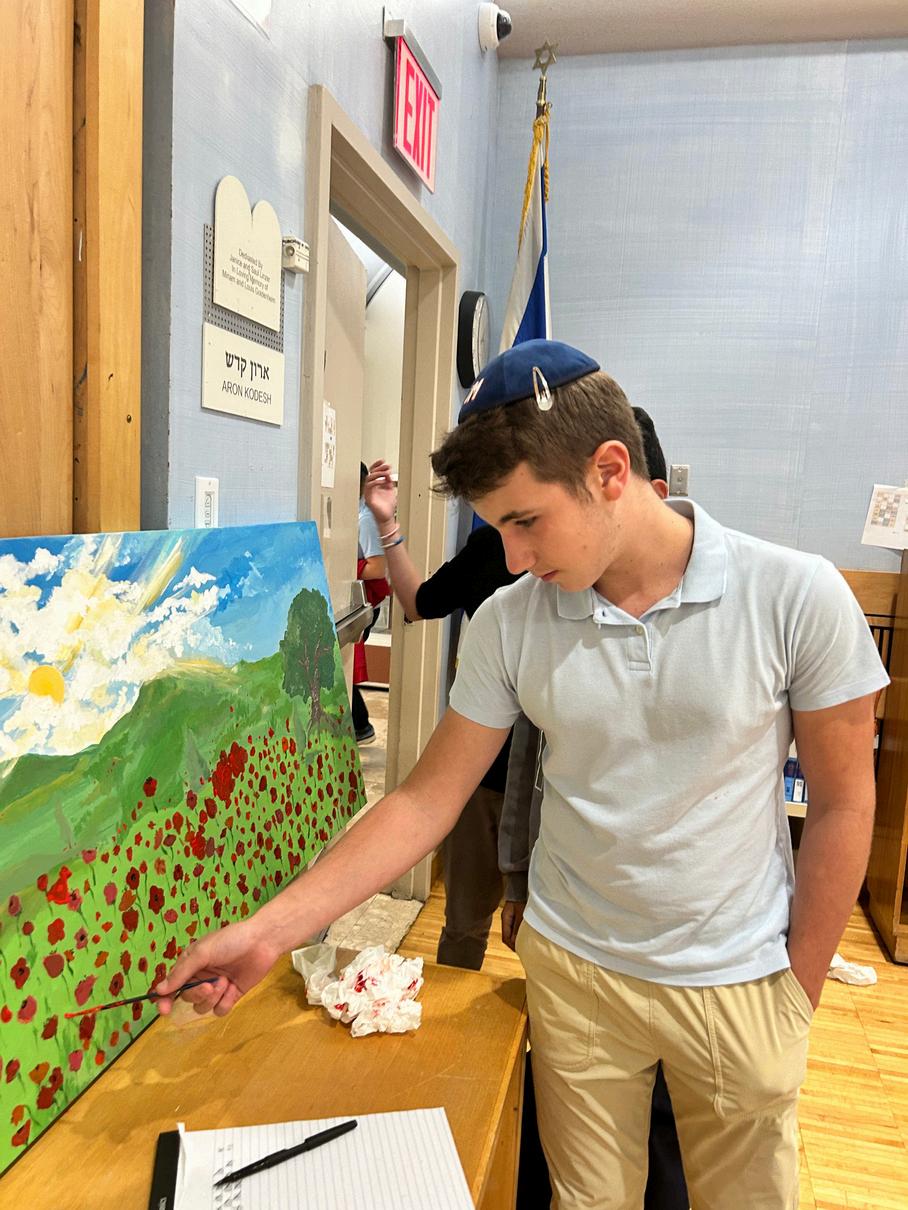


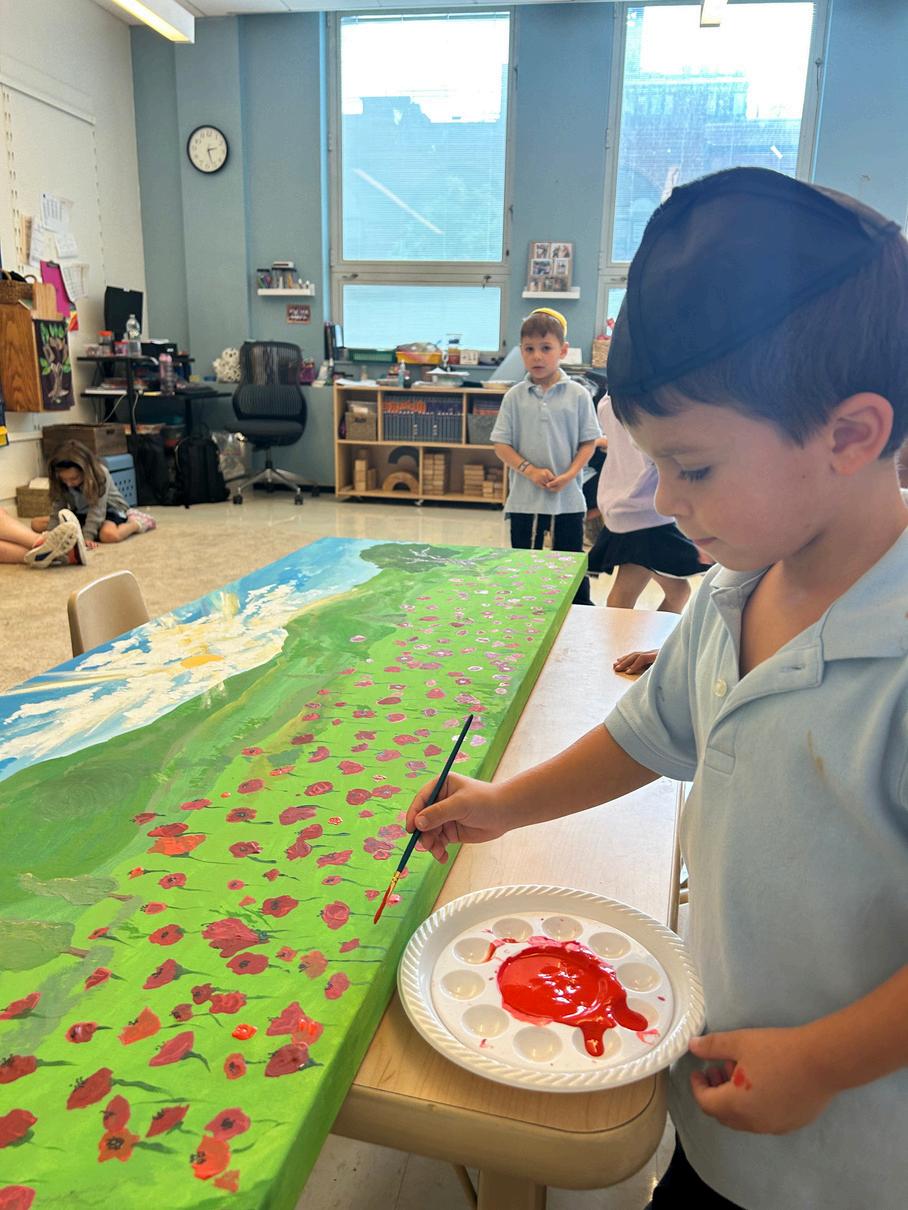

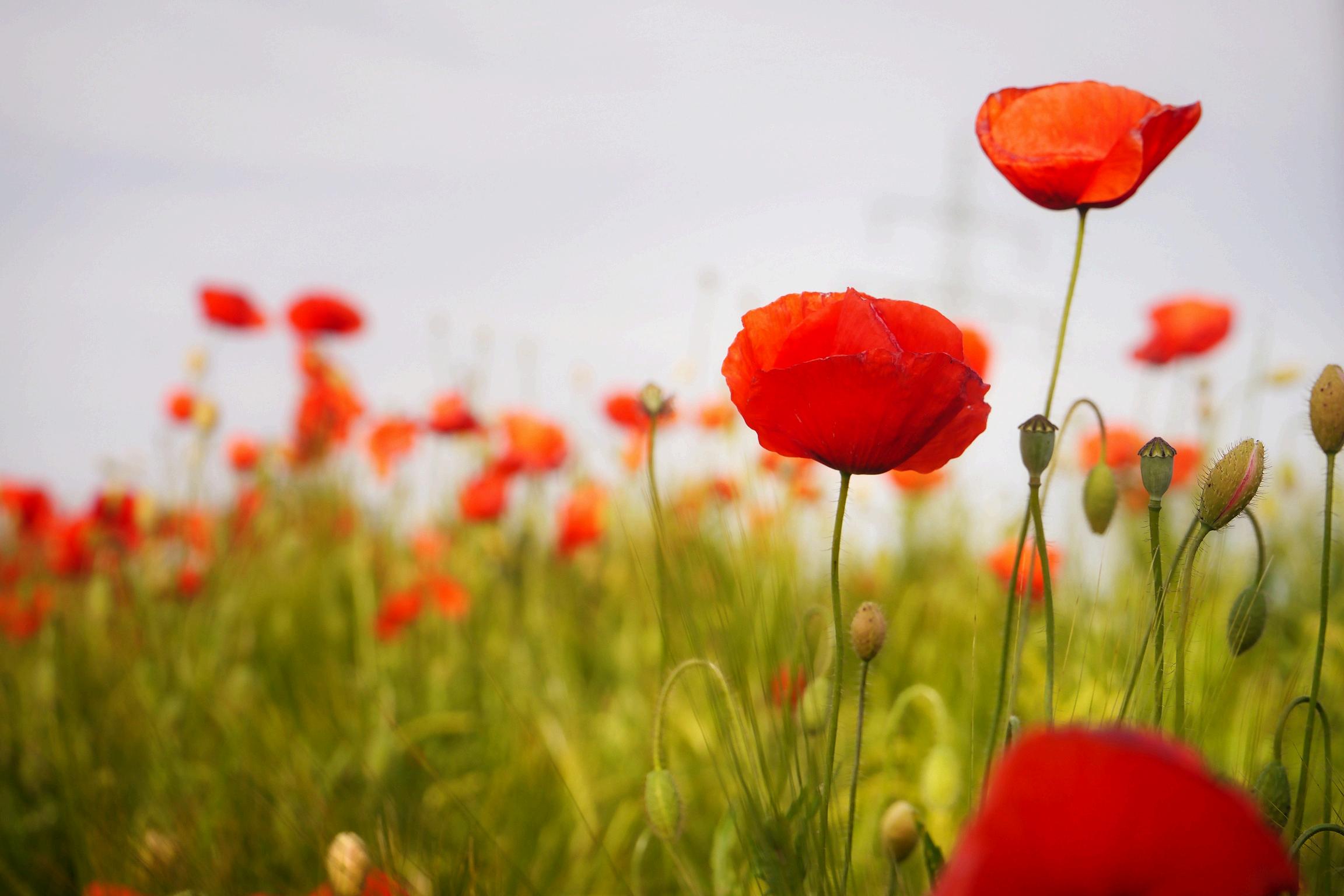





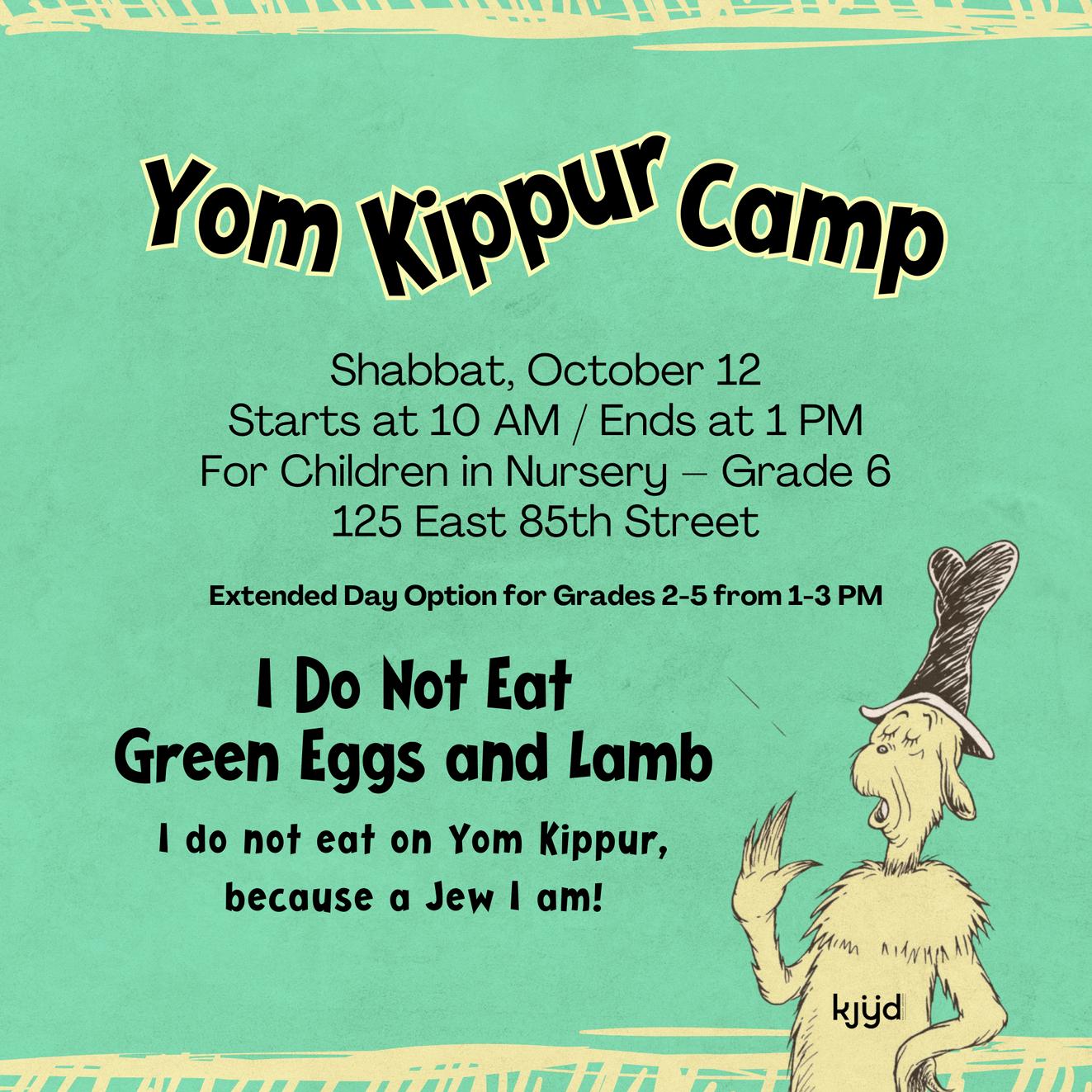







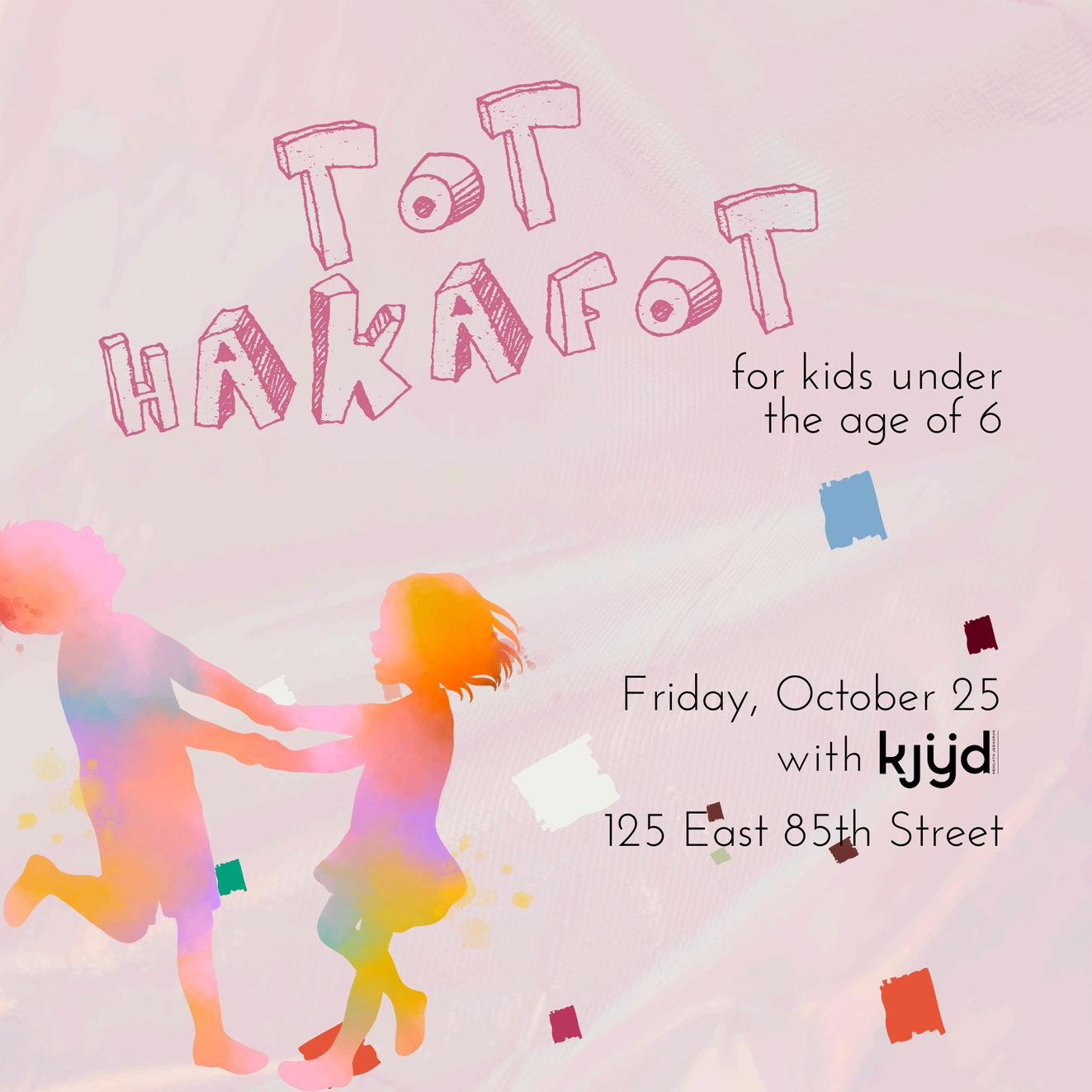

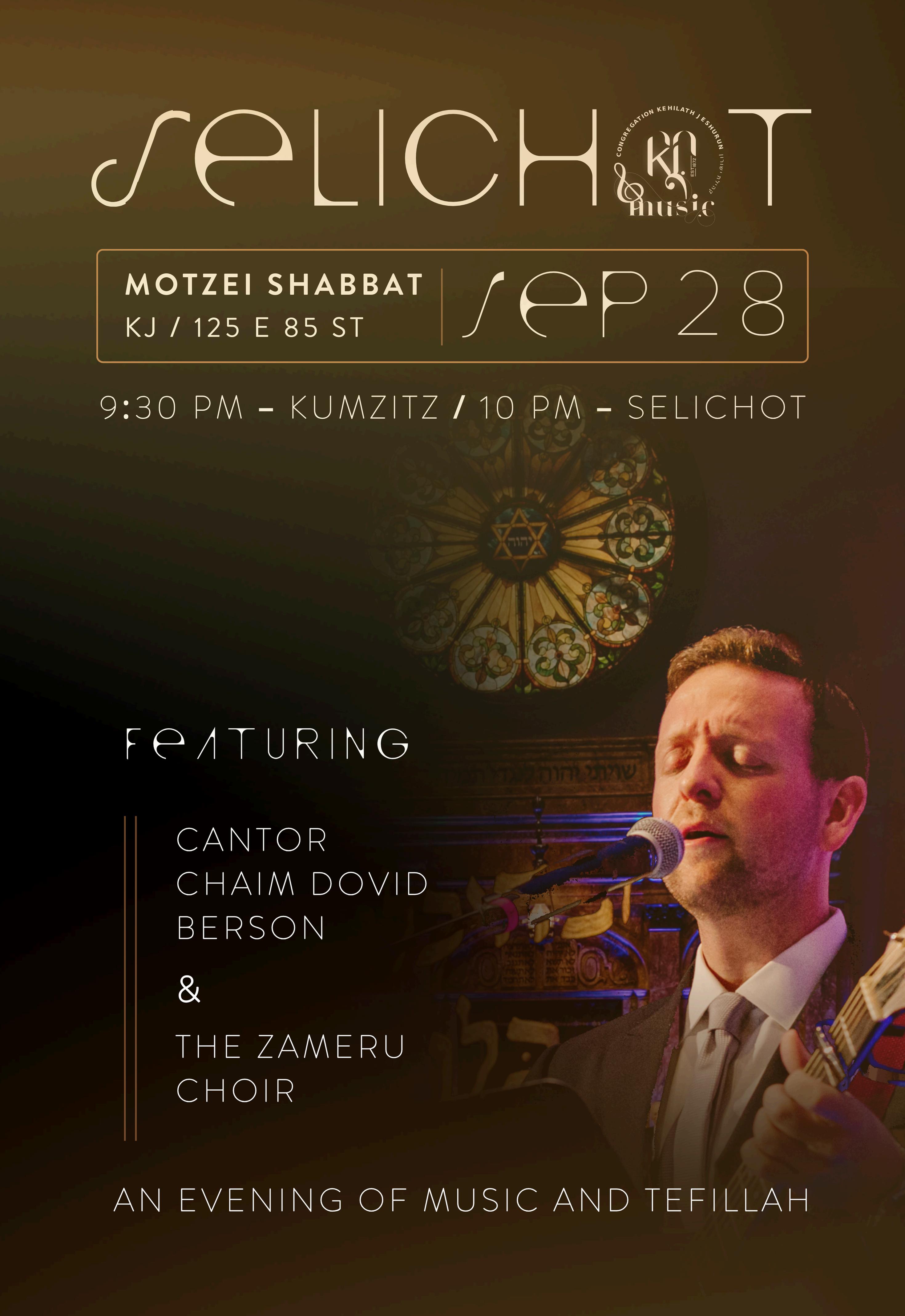

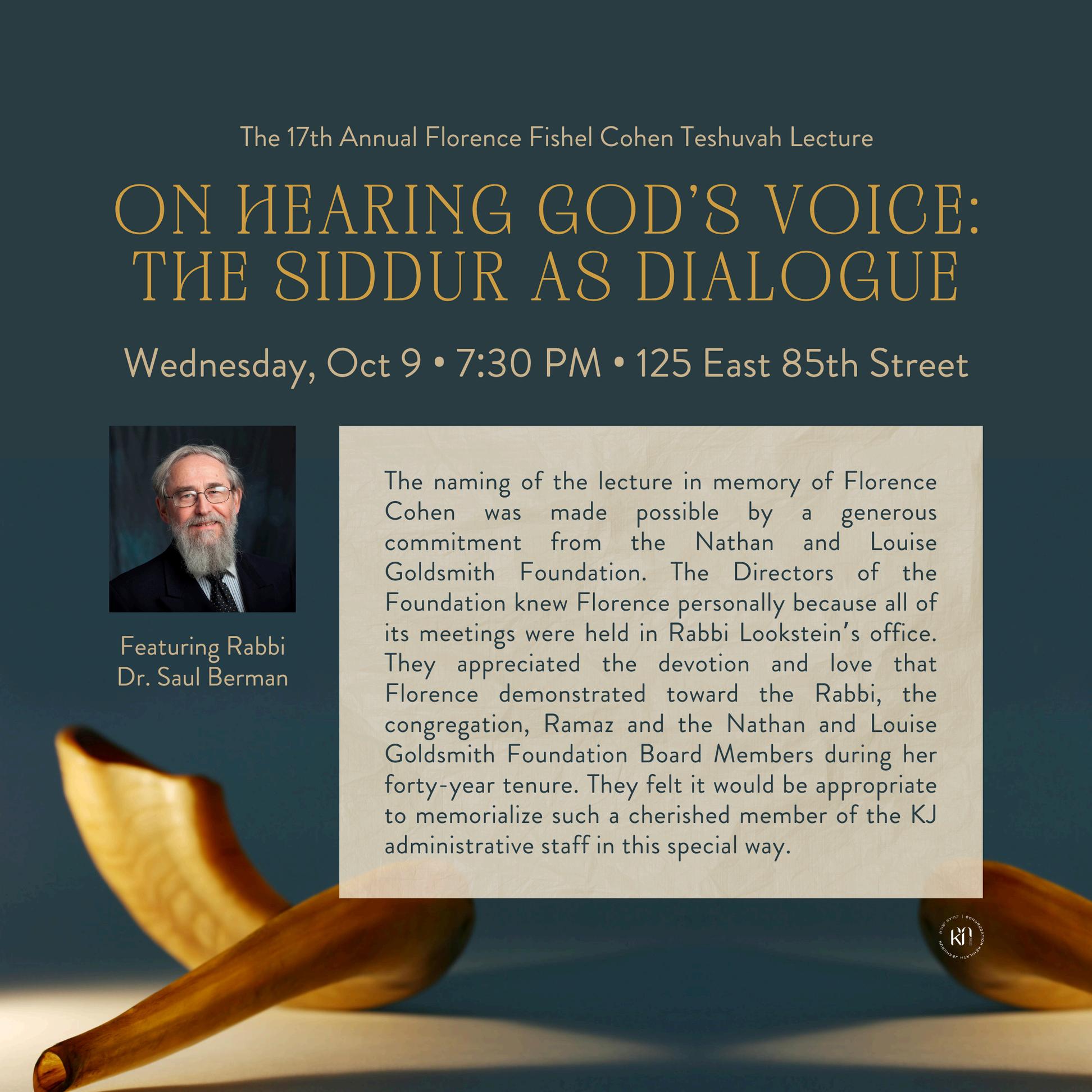



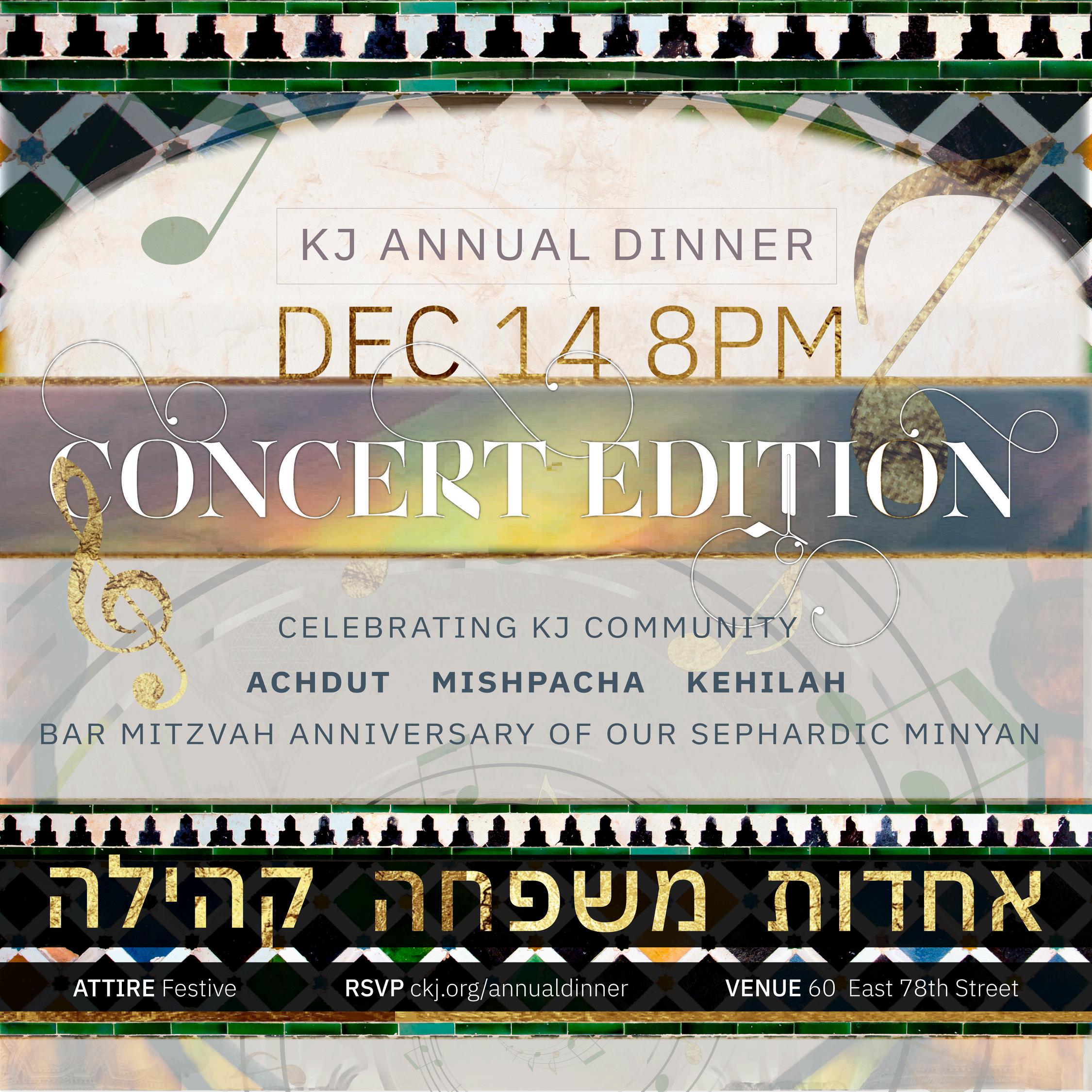
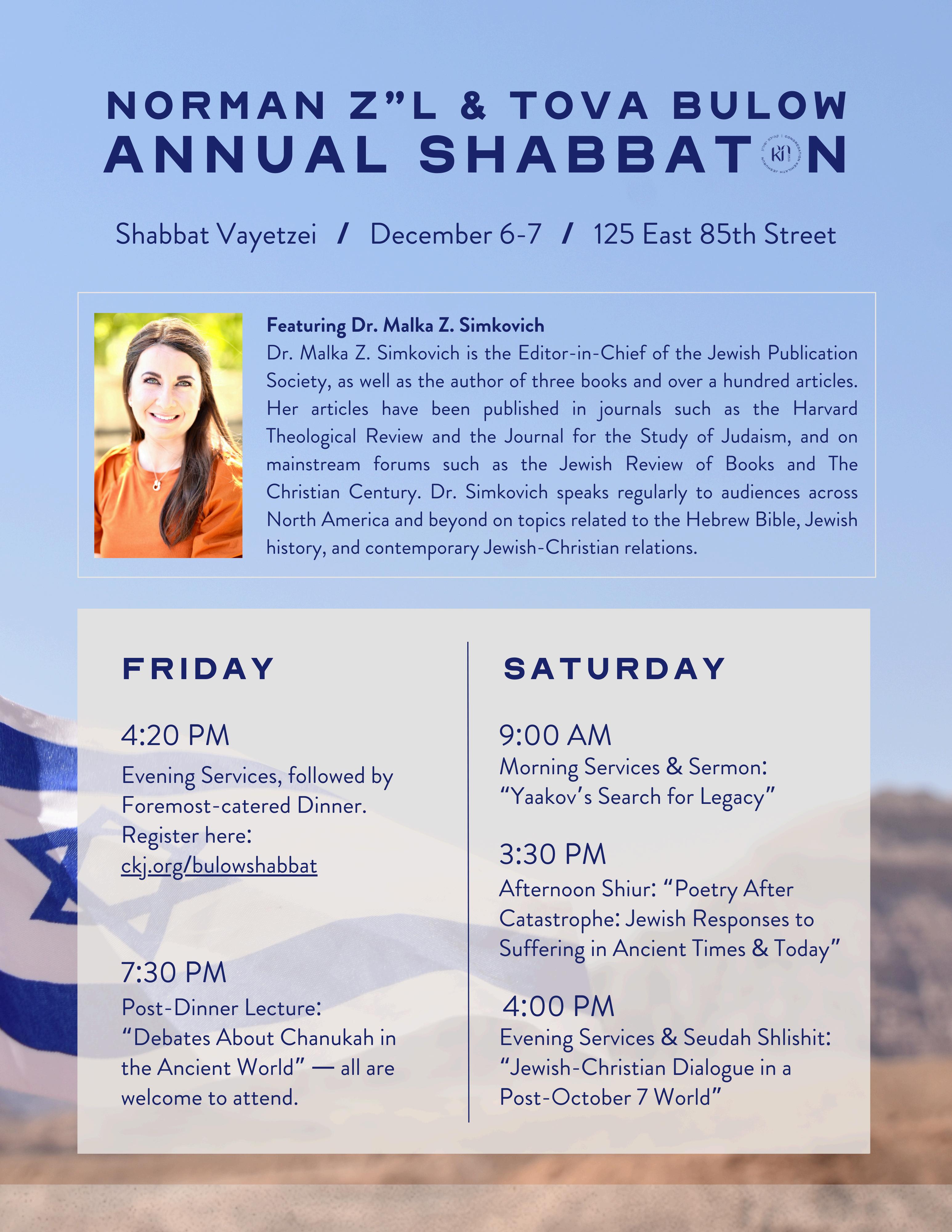


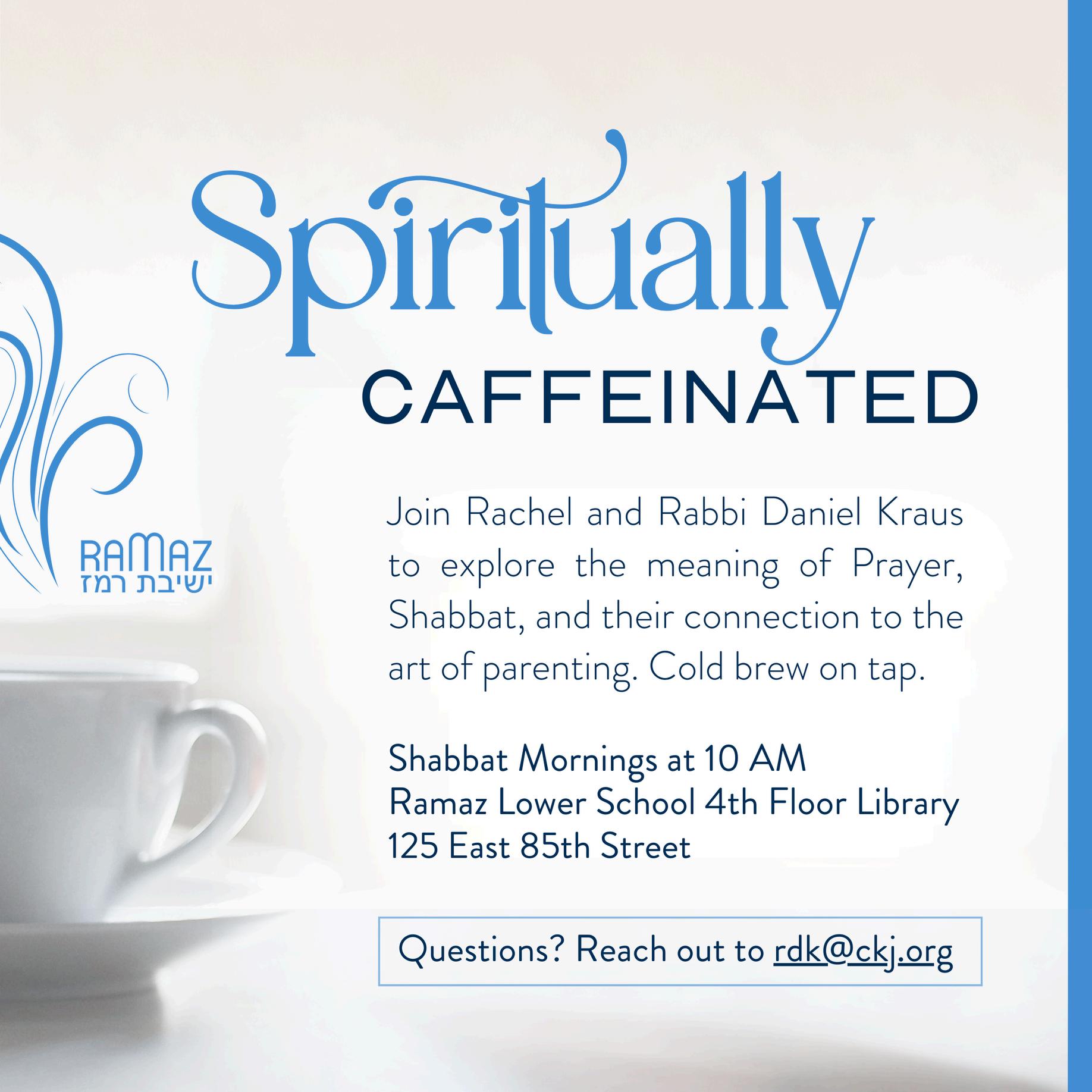

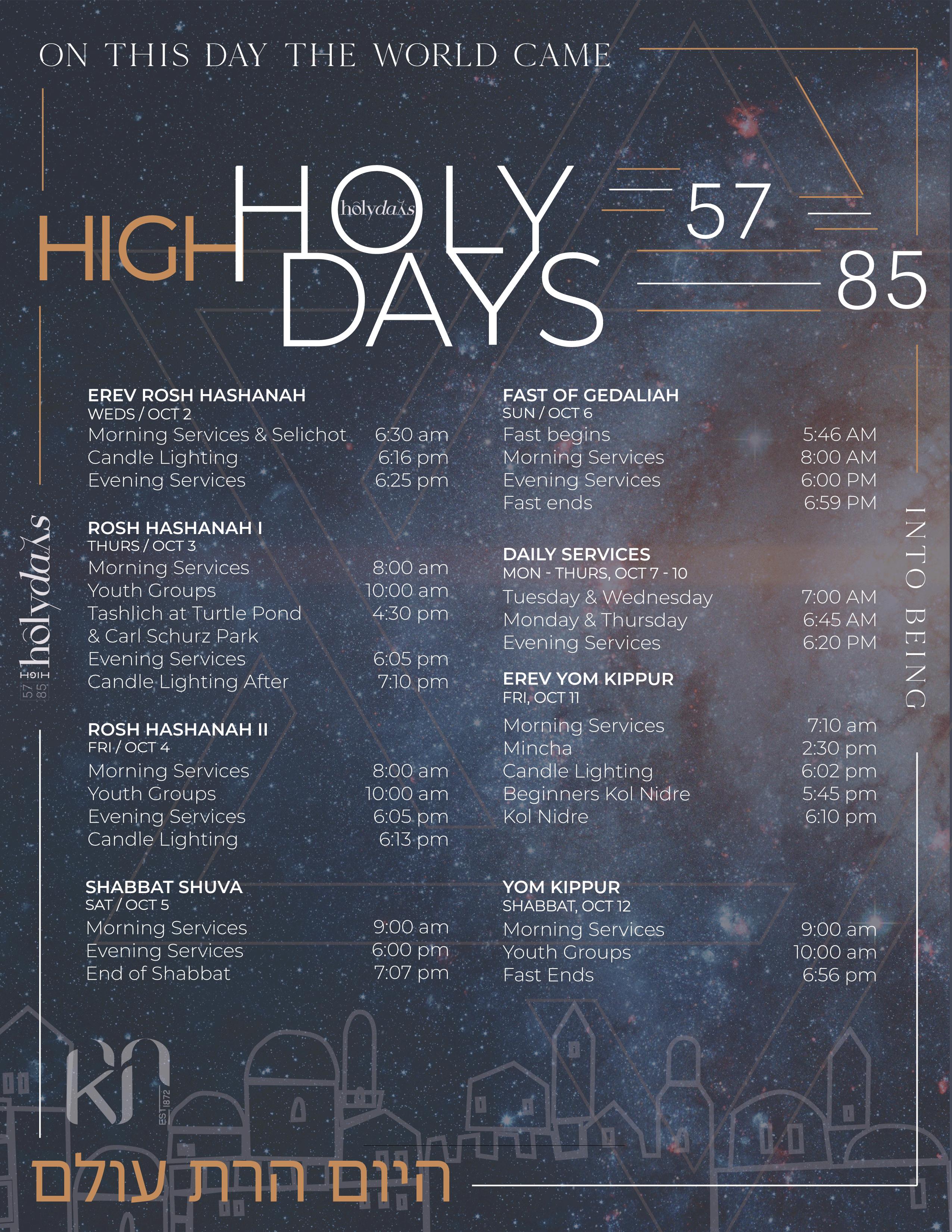


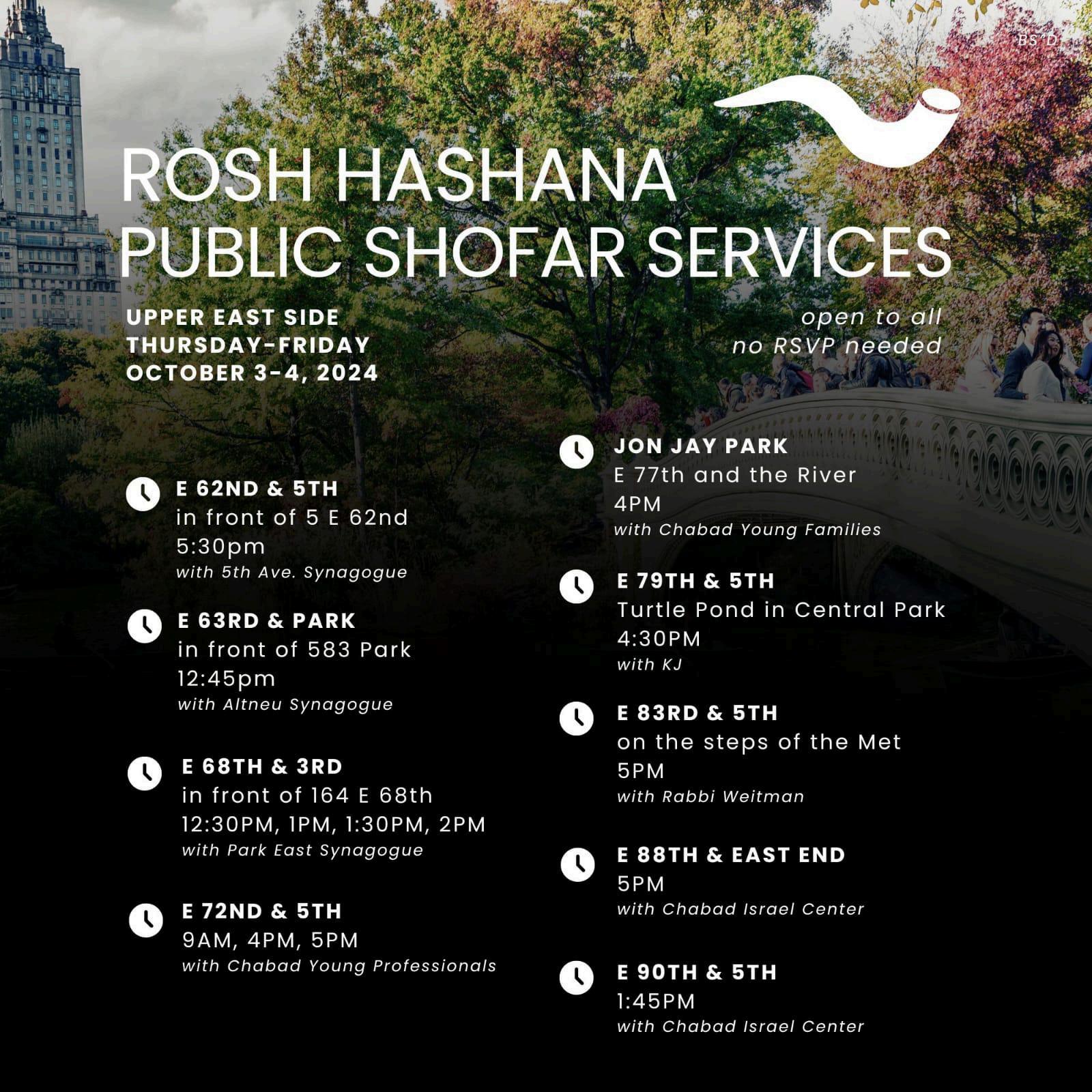

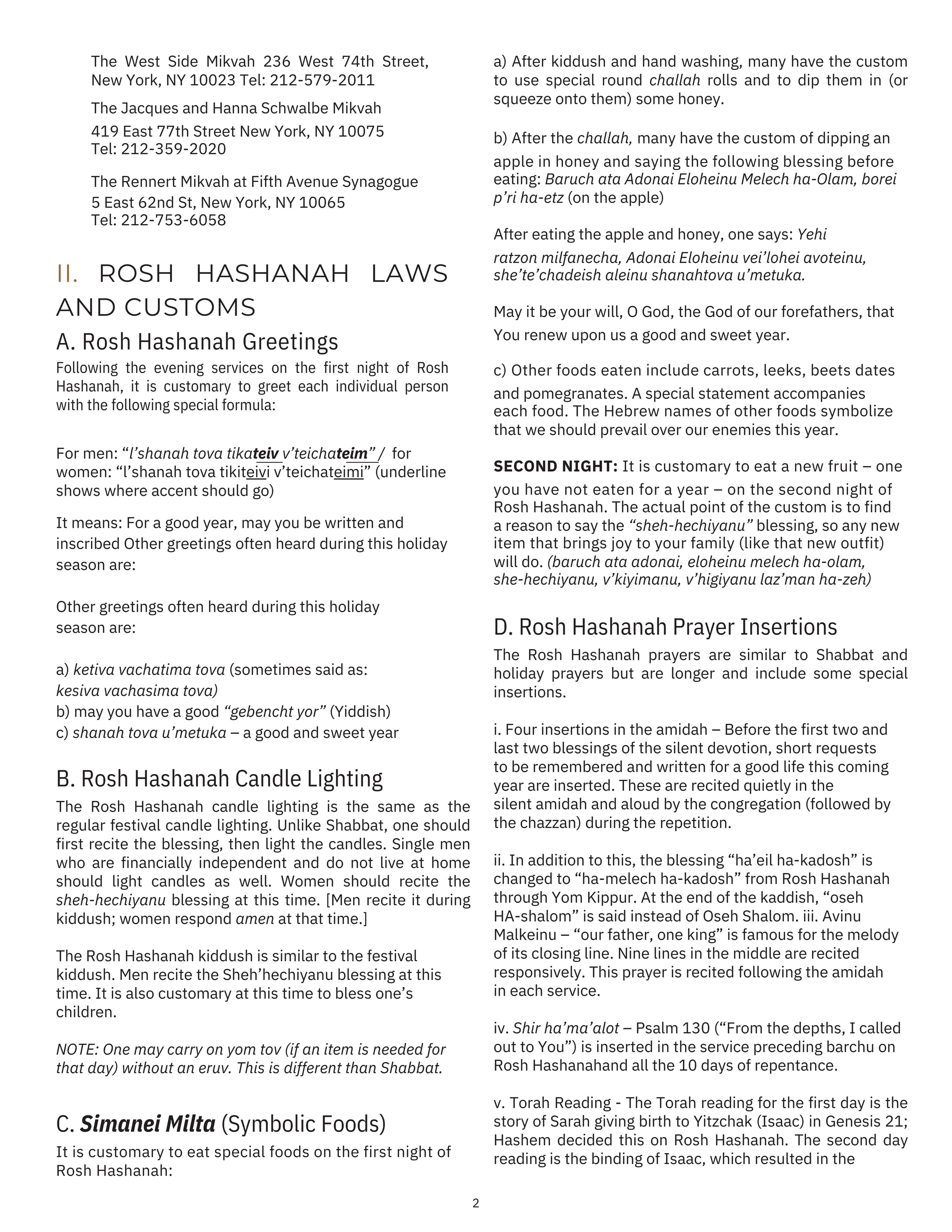


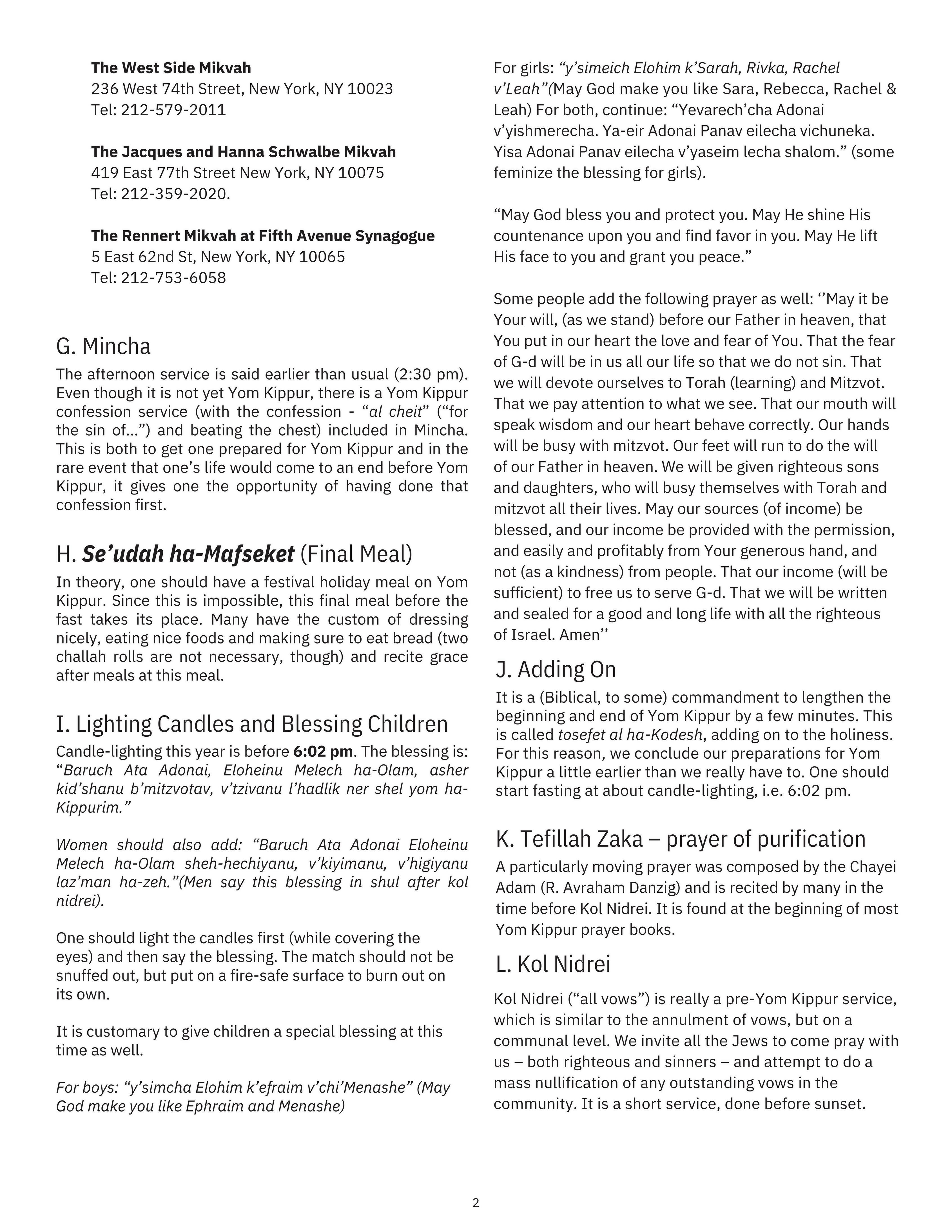


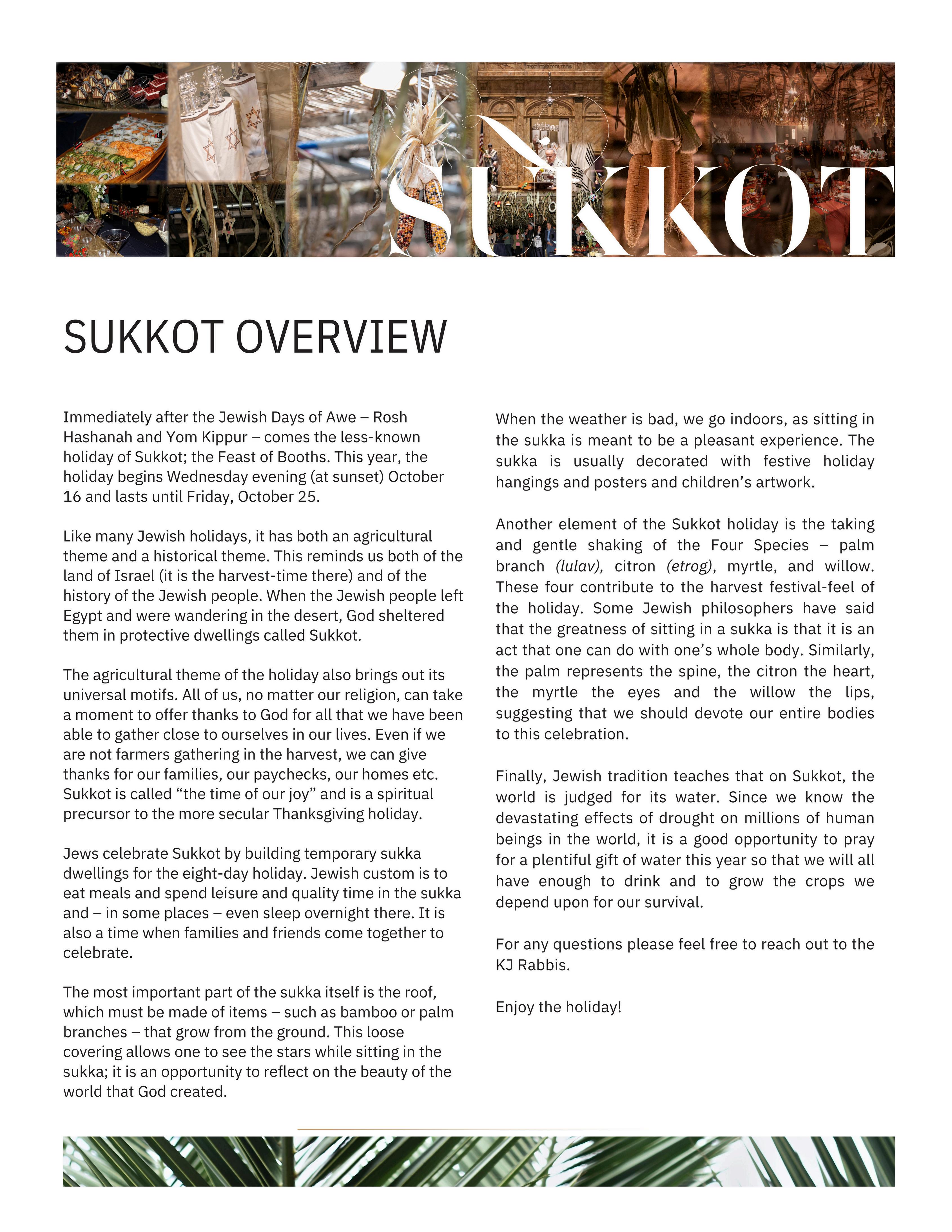

All meals with bread or mezonot should be eaten in a Sukkah. Sukkot catered meals required advance reservations and will be served in these two buildings. Contact sy@ckj.org if you need assistance. Visit ckj.org/sukkot to RSVP.
TABLES 1-21 are on the 8th Floor Roof of the Ramaz Middle School (114 East 85th St)
TABLES 63 and UP are on the 9th Floor Roof of the Ramaz Lower School (125 East 85th St)
Lulav and Etrog will be used beginning Thursday, October 17, and are not used on Shabbat. You may purchase a Lulav and Etrog from Israel through KJ by visiting ckj.org/lulavandetrog. Sets will be available for pickup in the Lobby Level Riklis Social Hall at 125 East 85 Street on October 14 from 7:30-8:45 pm and on October 15 from 8:00-10:30 am.
Kohelet is read by our High Schoolers. Thank you to all of our community readers:
Andrew Gage
Meir Kleinhaus
Berel Landerer
Lyon Levin
Michael Massel
Jonah Pike
Daniel Propp
Hoshanah Rabbah is on Wednesday morning, October 23, at 6:30 AM. It is the close of the penitential season High Holy Day melodies. Participate in seven circuits around the shul with Lulav and Etrog and beating of the Aravot.
The President’ s breakfast is sponsored by Phyllis and Jonathan Wagner.
Yizkor is recited. The prayer for rain is recited. Chatanim are presented to the congregation.
The officers of the congregation are pleased to announce that Sidney Ingber, Charles Zami, and Dr. David Landerer, three distinguished members of the Congregation, have been chosen for the highest Torah honors of the year
We invite the entire congregation to rejoice with them and with us on Shemini Atzeret and Simchat Torah, night and day, as we celebrate the three families whose love of, and commitment to, Torah merit our honor and tribute.
Simchat Torah is Thursday Evening, October 24. Bring your children at 6:05 PM to 125 East 85th Street. Our joyous evening of Hakafot in the Main Synagogue (evening Services begin at 5:50 pm) conclude with singing and dancing in the street, with Hakafot followed by a Simchat Torah extravaganza in the Ramaz Middle School featuring a festive dairy kiddush supper, ice cream bar, and a carnival of activities and entertainment for children of all ages. Divrei Torah from our community’ s children will cap our holiday celebration.
Simchat Torah Day is Friday, October 25 and will include youth groups, Hakafot with singing and dancing, the Chatanim called to the Torah, a Women’ s Tefillah Group meeting at 9:15 AM, and a buffet kiddush lunch following services.
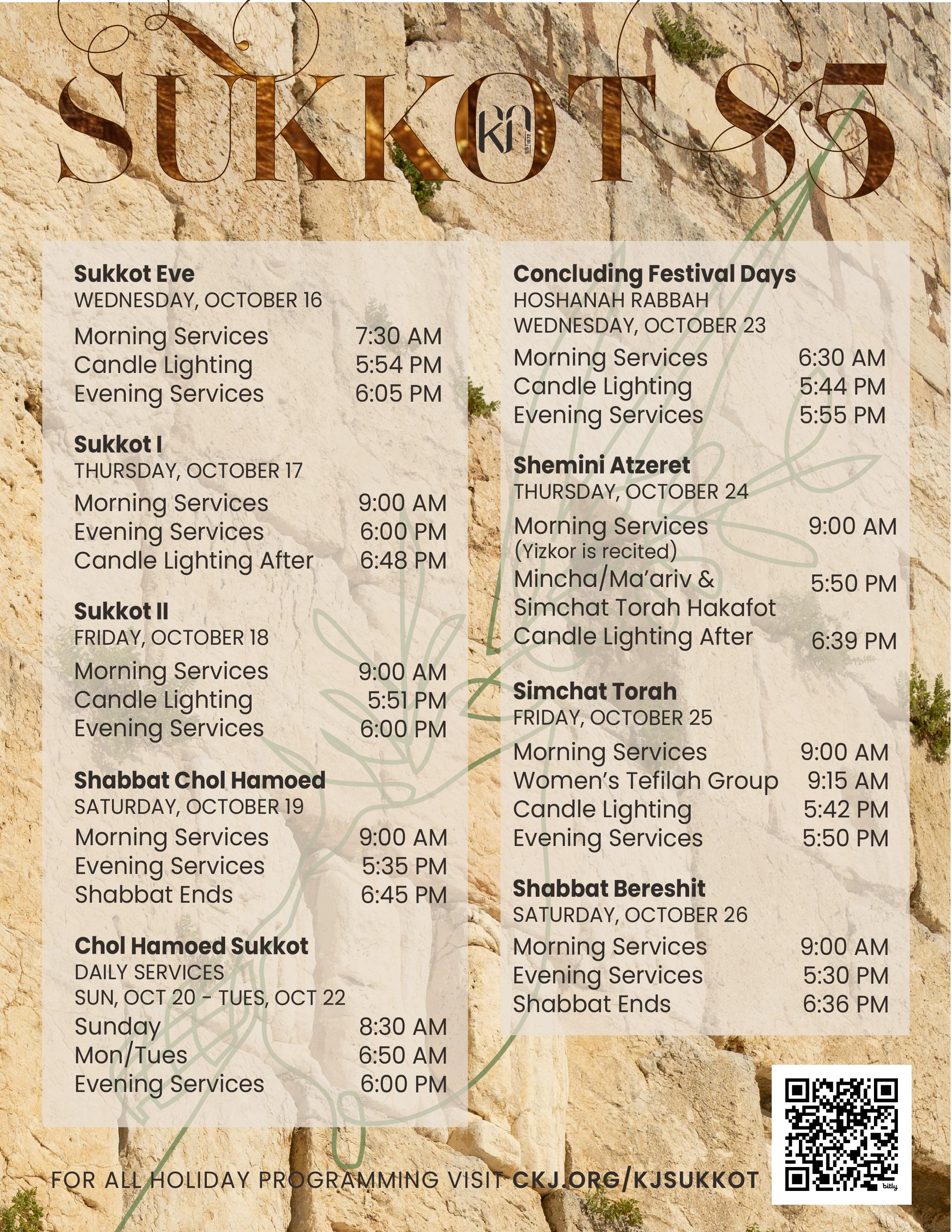

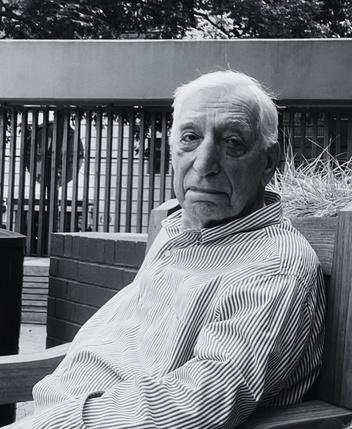
Sidney, his parents, younger brother, and maternal grandparents arrived in the United States in 1938, having narrowly escaped Nazi Germany. His paternal grandparents and other family members were murdered in the Holocaust.
Sidney received his education at the Rabbi Jacob Joseph School of Yeshiva University, and ater New York Law school. He practiced law for 56 years, retiring in 2017.
endy, settled and raised their family in Great Neck, where their children, Bettina, Amara, ommuted to Ramaz School Sidney and Wendy are very proud of the excellent education that the daily commute was well worth the gift of a Ramaz education.
In their suburban shul, the Great Neck Synagogue, Sidney caught the attention of the lay leadership and clergy and was soon tasked with one portfolio of responsibility after another, in keeping with the adage "If you want something done, give it to a busy person " Sidney eventually served as President of The Great Neck Synagogue
Sidney, Wendy, and especially their children and grandchildren, are all active participants in Jewish life and causes, both here in America, in Israel, and globally.
In 2007, Wendy and Sidney moved to the Upper East Side of Manhattan, at which time they happily joined the KJ community which warmly embraced them and provided many lasting friendships. Repeating his commitment to community service, Sidney volunteered to run events and was soon appointed to the KJ Board of Trustees where he faithfully served as both Trustee and Officer. He has been a trusted and valued counselor to KJ rabbis and presidents alike.
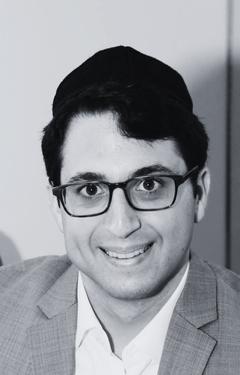
Charles Zami, our Chatan Bereishit, has been the assistant chazzan at KJ Sephardic for the past seven years and counting. Having grown up in the Syrian community of Brooklyn, NY, Charles was taught chazzanut and baal keriyah from a young age Just five weeks after his Bar Mitzvah, he was hired to be the full time ba’al koreh of Magen David of Belle Harbor. Since then and over the last 20 years, he has been the ba’al koreh at various synagogues in Brooklyn, Deal, and now Manhattan
Anyone who comes to the Rohr Chapel on Shabbat morning will hear Charles’ flawless Torah reading But anyone who comes to this building on Sunday morning will witness what makes Charles invaluable to us. Over the last five years, Charles has helped established a Sephardic Youth program, where the children learn how to properly recite various texts according to the Sephardic tradition.
Professionally, Charles is the Director of Analytics and Technology Innovation at Centers Health Care, guiding data and technology strategy across over a dozen different healthcare entities. Charles is also a consultant to El Al airlines, having been instrumental in expanding the selection of Torah Shiurim available in flight He also played a key role in expanding the “no-fly on Shabbat” policy to include 3-4 hours pre and post Shabbat.
Charles and Rosy moved to the Upper East Side in 2015 and immediately felt at home within the KJ community. Rosy and Charles’ greatest contributions to the community are their wonderful young children: Sarah, Juliette, and Morris Although too young to join the youth program now, Charles has already started teaching them Sephardic melodies at home and is excited to welcome them to his class in just a few years.
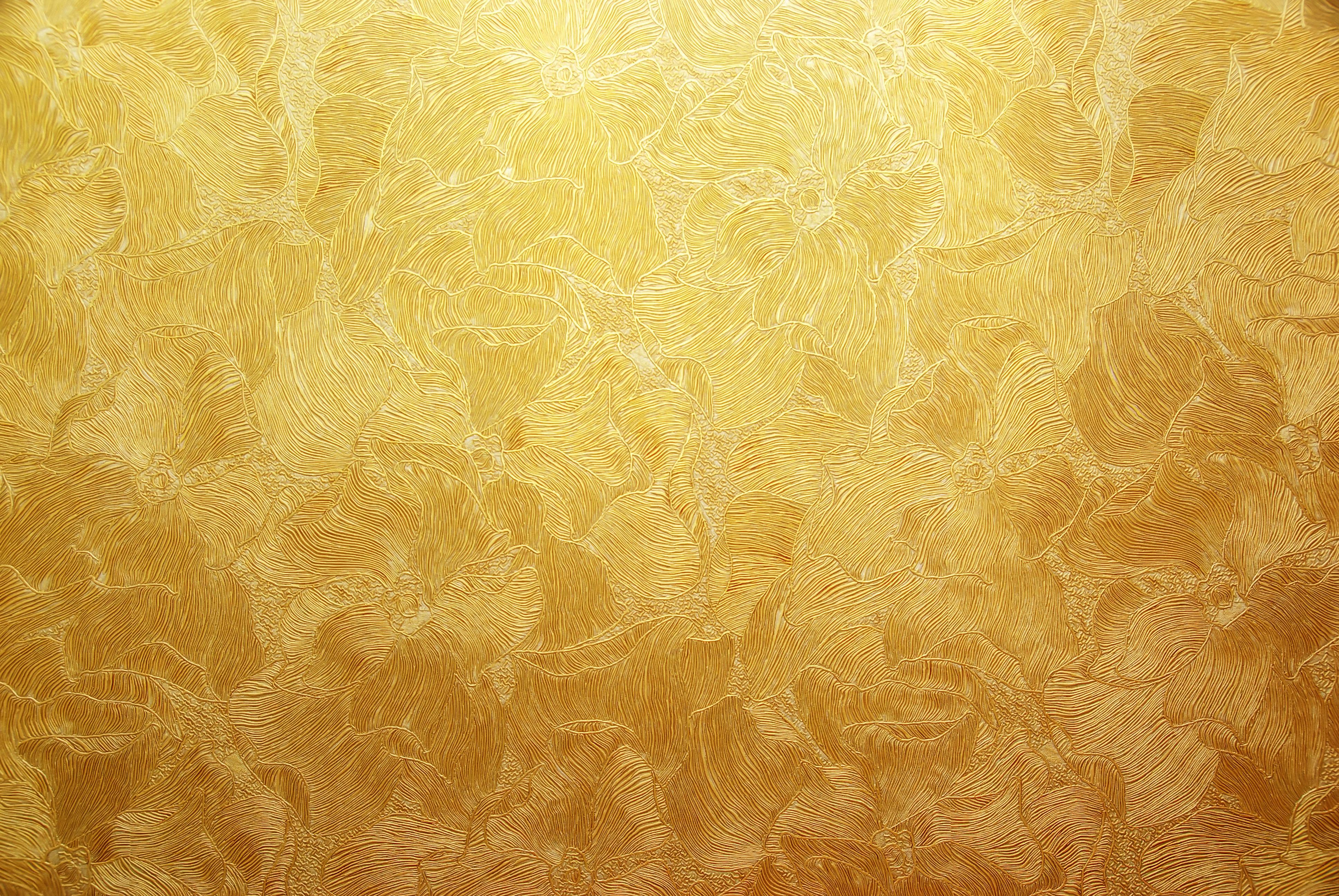
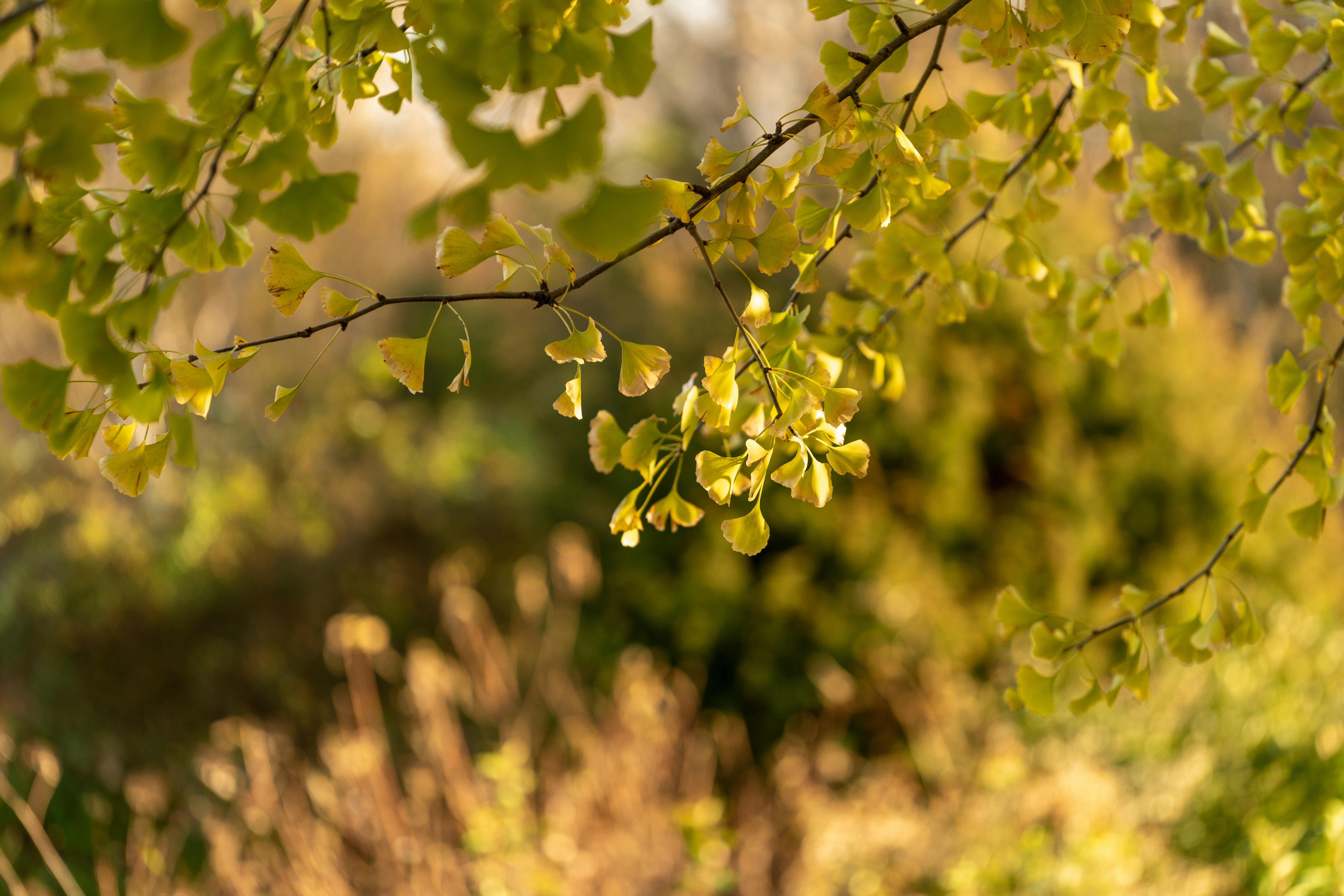
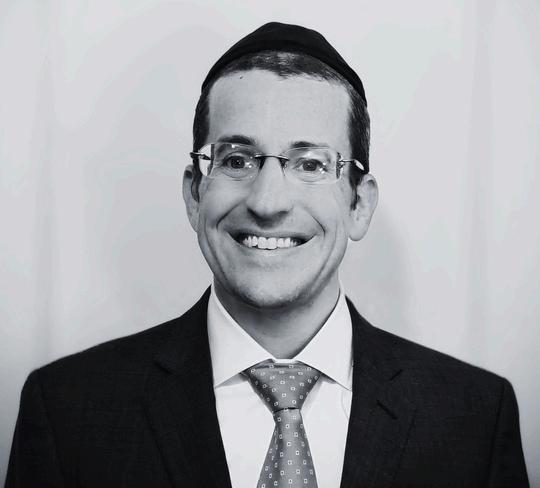
David is truly honored to be receiving the Chatan Maftir aliyah in KJ on this upcoming Simchat Torah David, his amazing wife Suri, and their beautiful children, Berel, Moshe, Simcha, Mayer, Bayla, and Menachem, all feel like KJ is their second home and extended family. They are so humbled to be a part of such a prestigious shul with world-renowned rabbis, and they are so grateful for the warmth of such a friendly congregation.
David was raised in Teaneck, New Jersey, in a loving, Torah-observant household that was focused on family and chesed, and that instilled in him a discipline of work ethic to achieve his goals. David and his family davened at Congregation Bnai Yeshurun. It was there that David began his love for davening and layning and his appreciation for the significance of being actively involved in shul
David attended Yavneh Academy for elementary school and then MTA for high school. He went early admissions to Yeshiva University for one year. He then studied for two years in Yeshivat Kerem B’Yavneh in Israel where his love of learning Torah and love of Eretz Yisrael were solidified He then returned to Yeshiva University to complete his undergraduate degree and learned in Rav Herschel Schachter' s shiur for four years. After graduation from YU, he spent a year in the YU Kollel before beginning Robert Wood Johnson Medical School in New Jersey.
During his second year of medical school, David met Suri (nee Rothman) who was raised on the Upper West Side and at the time was teaching at the Ramaz Middle School. They got married after his second year of medical school, lived for two years in Teaneck and then moved to the Upper East Side in 2006 when David began his residency in Internal Medicine at Lenox Hill Hospital. After completing his residency in 2009, he began working and continues to work at ODA Primary Health Care Center in Williamsburg as a primary care physician for adults Many of his patients have been under his care continuously for several years, and he has forged deep relationships with them and their families.
David prioritizes his time. He is fond of saying, “Time is the most precious commodity and must never be wasted.” Although he works many hours in the office caring for his patients, of course the most important time in his day and what he cherishes the most is spending precious time with his wife and children. His greatest joy in life is learning Torah and davening with his children, enabling him to pass down our treasured mesorah (tradition) to the next generation.
David tries to also stay disciplined regarding his remaining hours of each day He davens at KJ daily and layns regularly. He learns Daf Yomi daily with Rabbi Aryeh Lebowitz whose shiurim are online, and David is a proud sponsor of this amazing shiur. He loves learning Tanach and was one of the eight finalists in this past year ' s Adult Chidon HaTanach Each week on Motzei Shabbat, he completes an online Chumash and Rashi test covering that week' s parsha He also takes an online Mishnayot test every week on a set number of Mishnayot
David is an avid runner and is always training for the next marathon. He has run 11 NYC Marathons while raising money for Chai Lifeline and will be running his 12th NYC Marathon in November, again in support of this meaningful organization and in memory of his dear mother, Mrs. Gail Landerer a ”h, who passed away two years ago.
David is a huge sports fan and enjoys following and playing sports with his children. He shares a passion for the Mets with Rabbi Lookstein and for the Jets with Rabbi Steinmetz He is hoping for one day to be able to sponsor a kiddush after one of his teams wins a championship. He has been waiting for that day for a long time…
David loves being able to give back to KJ, his second home. When called upon, he is ready and willing to layn, be a baal tefillah, be the gabbai calling up the aliyot, and give a Daf Yomi siyum He cherishes being Chazzan Berson’ s “backup singer” during davening and Rabbi Lookstein’ s partner in reciting Tehillim.
It is very significant to David and Suri to pass along this love for and responsibility to the shul to their children. Berel davens for the amud and layns regularly every week Moshe earned the title as the “Cal Ripken of Yigdal ” Simcha and Mayer often help with g ’lilah and as well have given Divrei Torah on Shavuot. Bayla enjoys helping her brothers at havdalah every week, and Menachem loves coming to shul and admiring his family' s participation.
Berel is in the 10th grade at Yeshiva Shaar HaTorah in Queens Moshe (6th grade), Simcha (4th grade), Mayer (2nd grade), and Bayla (Kindergarten) attend Yeshiva Ketana of Manhattan on the Upper West Side, and Menachem enjoys the quiet time with Mommy while his siblings are in school and enthusiastically plays with everyone when they return home Suri feels tremendous gratitude to Hashem for the cherished gift of being home taking care of the children with tireless dedication and love




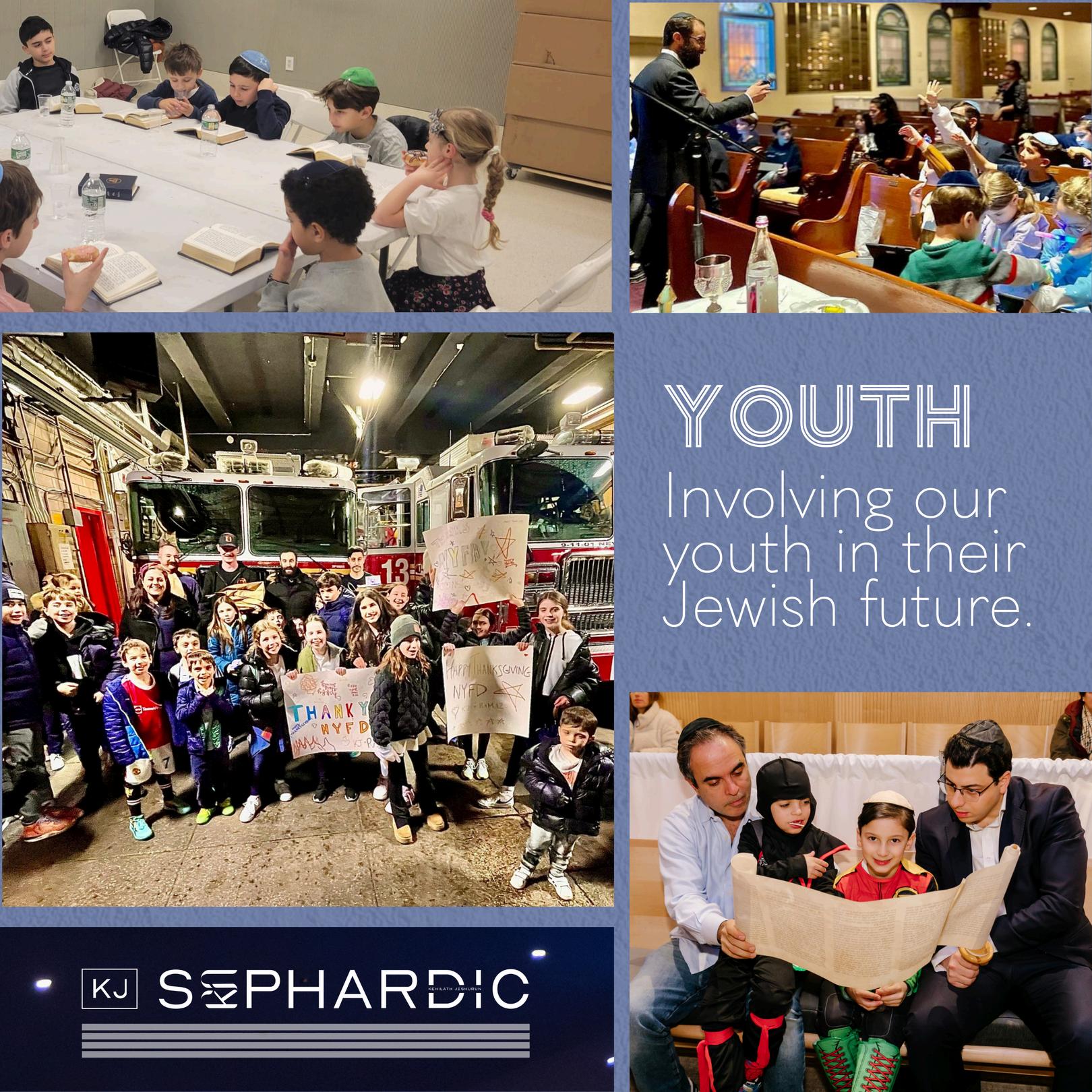



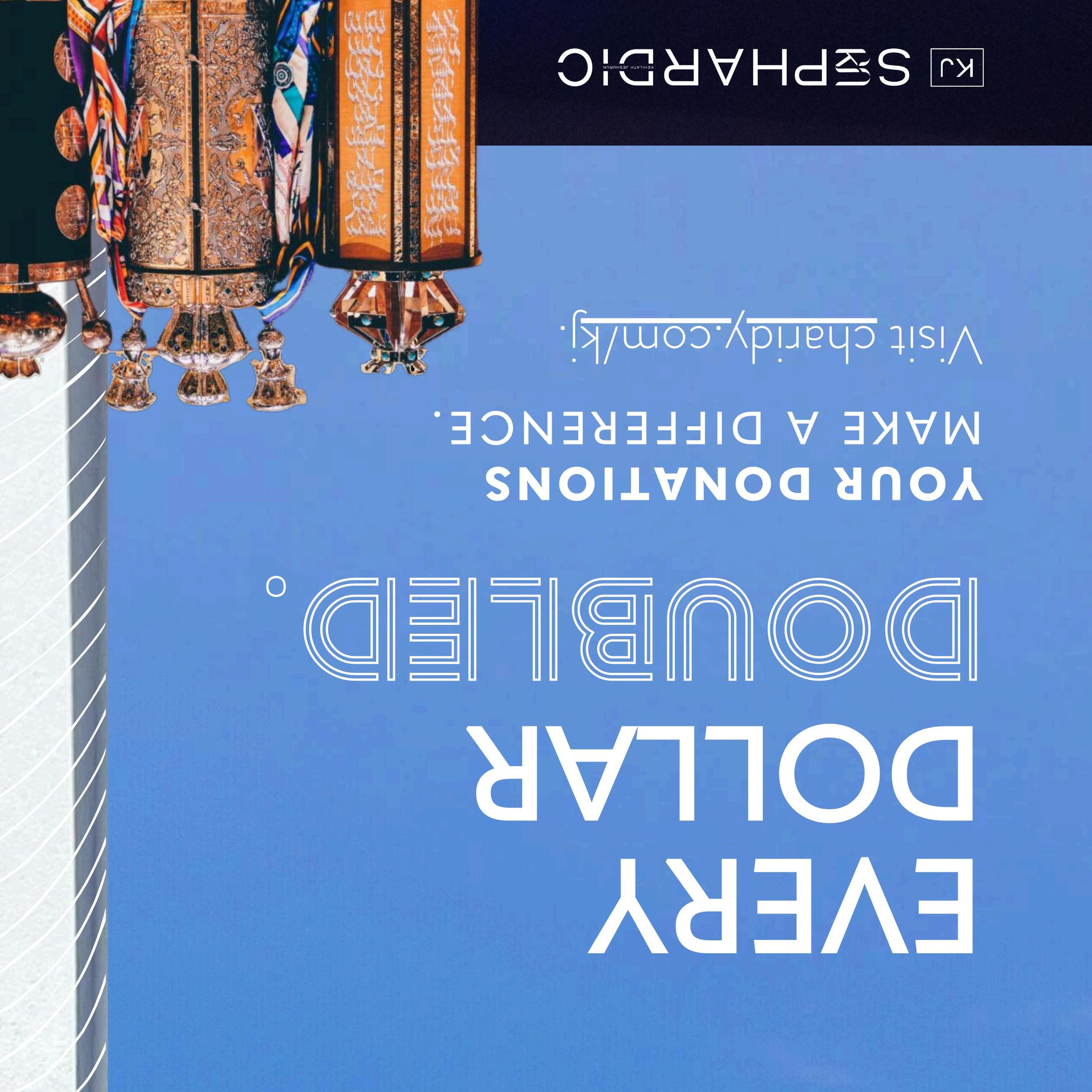

OurKJSephardiccommunityisthrivinglikeneverbefore.Whatsetsusapartisourcommitmenttomaintaining our rich Sephardic traditions while being an integral part of a larger, united community that embraces both Sephardic and Ashkenaz members. This past year has been a testament to our growth, unity, and dedication to oneanother
Inresponsetothegrowingdemand,we’veexpandedouryouthprogrammingwiththeadditionofanewclasstier forourShabbatmorningprogram ThisincludesanadvancedclassledbyAssistantHazzanCharlesZami,helping our children develop leadership skills in tefillah, Torah reading, and pizmonim. Our Saturday night programs, alongwithspecialrafflesandarobustprizesystem,havefurtherenergizedandengagedouryouth,ensuringthey feelconnectedtothecommunityandtheirgrowthinTorah,Tefillah,andMisvot.
We’vealsobroadenedourTorahclassofferingstoinclude"UnderstandingtheAmida,"andan"IntrotoTalmud" course, in addition to our Jewish philosophy classes, and our daily Shulchan Arukh studies. Additionally, we have enhanced our kiddushim and social events, fostering deeper social connections within KJ Sephardic and strengtheningtieswiththebroaderKJfamily.
KJSephardicismorethanjustaminyan;it’savibrantcommunitywhereSephardictraditionsarepreservedwhile also being an integral part of the broader KJ family
This past year, our Bar Mitzvah celebration, with three Sephardic Hattanim honored in the Main Sanctuary for Simhat Torah, was a moment of profound unity. Cantor Berson’ s inclusion of Sephardic tunes beautifully echoed through the sanctuary, symbolizing the harmony and strengthofoursharedcommunity—distincttraditions,oneunitedfamily.
Our sense of community extends beyond our Sephardic members, embracing the entire KJ family Whether through our annual pre-Thanksgiving Firehouse and Police precinct visits, where our children deliver meals and cards of gratitude, or our winter ski trip, which gathers 40-60 families, our events strengthen the bonds that holdustogether.Theonce-againsold-outKJSephardicdinner,enjoyedby250people,isyetanothertestament tothestrengthandunityofourcommunity
Our unwavering dedication to Torah study is the beating heart of our community. Over the past year, we have completed20booksofHalachaBerura,andwearesettocompleteShulchanArukhOrekhHaimnextyear We willjoyfullycelebratethiscommitmenttolearningandspiritualgrowthduringSimhatTorah.
Inaddition,werecentlycelebratedoneofourmembers'completionofMasekhetShabbatwithaspecialShabbat and Kiddush, and have expanded our educational offerings to include a women ’ s "Understanding the Amida" class and an "Intro to Talmud" class, demonstrating our deep commitment to engaging with our rich rabbinic traditions.
Youth engagement is at the core of our mission, ensuring the continuity and vibrancy of our community for generationstocome OurAssistantHazzanCharlesZami,hasledourSundaymorningyouthclass,preparingour children to properly read and lead tefillah, Torah reading, pizmonim, and megillot for the holidays. Our robust ‘early-bird-special’Shabbatmorningraffleprogramhasinspiredouryoungmemberstoapplytheirlearningfrom theseclassesandtakeanactiveroleinourKJSephardicminyan,leadingthePesukeDezimraandrecitingShema in unison This initiative has been a resounding success, with 15 to 20 kids participating each Shabbat Many of these young leaders have even taken on the responsibility of reading from the Torah, receiving their own personalizedTikkunaftertheirthirdreading
We are excited to introduce a next-level class with a new incentive program to continue nurturing our youth’ s growth in Torah and prayer These young voices are the future of our community, and we are dedicated to providingthemwiththeguidanceandopportunitiestheyneedtoflourish.


HaileyandSolAdleruponthebirthoftheirfirstchild anddaughter,BlairLielle.
LeandraandAbeCohenuponthebirthofadaughter, Joelle(ChanaRivka).
Danielle and Zach Cooper upon the birth of a son Mazal Tov as well to delighted KJ grandparents, DeborahandMarkCooper.
JewelandTedEdelmanuponthebirthofagrandson, borntotheirchildren,ShaynaandJasonEdelman
TaliaandJeremieGarzonuponthebirthofason.
SueandDr.NormanJavittuponthebirthofagreatgrandson, Yosef Yakir, born to their grandchildren Naomi and Eli Diamond of Givat Shmuel, Israel, and also to the grandparents, Kim and Joel Javitt of JerusalemandJudyandEtanDiamondofEfrat
Terry and Michael Jaspan upon the birth of a granddaughter born to their children Arielle (Ramaz '01)andJosephJaspan(Ramaz'01).
Ruth and Larry Kobrin upon the birth of their great granddaughter, Tamar Shoshana Wiener, daughter of Yaira Kobrin and Solomon Wiener, granddaughter of MichelleandRabbiJeffreyKobrin.
Julie and Rick Lobel upon the birth of a granddaughter,EdenSky,borntotheirchildren,Tara andBarnettLobel.
Aliza and Steven (Yanky) Major upon the birth granddaughter, Eden Carmel, born to their ch Abigail and Gabe Siegal. Mazal Tov to delight greatgrandmotherGabrielleMajor.
Nicole Lieberman & Adam Scharaga upon the oftheirfirstchildanddaughter,SydellRuby.
Debbie and Daniel Schwartz upon the birth granddaughter, Aria Lev, born to their children, and Yishai Schwartz. Mazal Tov to delighted KJ grandmotherGabrielleMajor.
Phyllis and Jonathan Wagner upon the birth of a granddaughter, born to their children Anna (Ramaz ’11) and Elisha Galler.
Danielle and Joshua Weinreb upon the birth of their first child and daughter, Kaylie Pearl.
Eliyahu and Tali Ziskind upon the birth of a daughter.
May these children grow up in the finest tradition of Torah, chupah, & maasim tovim.
bnei mitzvah
Rosie and Dr. Mark Friedman upon the Bar Mitzvah of their grandson, Shalom David Farkas, of Woodmere. Mazal Tov to Shalom’ s parents, Yael (Ramaz ‘2001) and Pinny Farkas, and his siblings, Moshe, Miriam, Yaakov and Talia.
Vanessa and Michael Hosana upon the Bat Mitzvah of their daughter, Eden.
Lisa Sopher and Jeremy Deutsch on the Bat Mitzvah of their daughter, Julia Fay Deutsch
Dr. Laury and Jason Paul on the Bar Mitzvah of their son, Elijah Paul.
Beth and Michael Weiss upon the Bar Mitzvah of their son, Noah.
Nirit and Michael Shaoul upon the Bar Mitzvah of their son, Einan, at the Jewish Community of Japan in Tokyo.
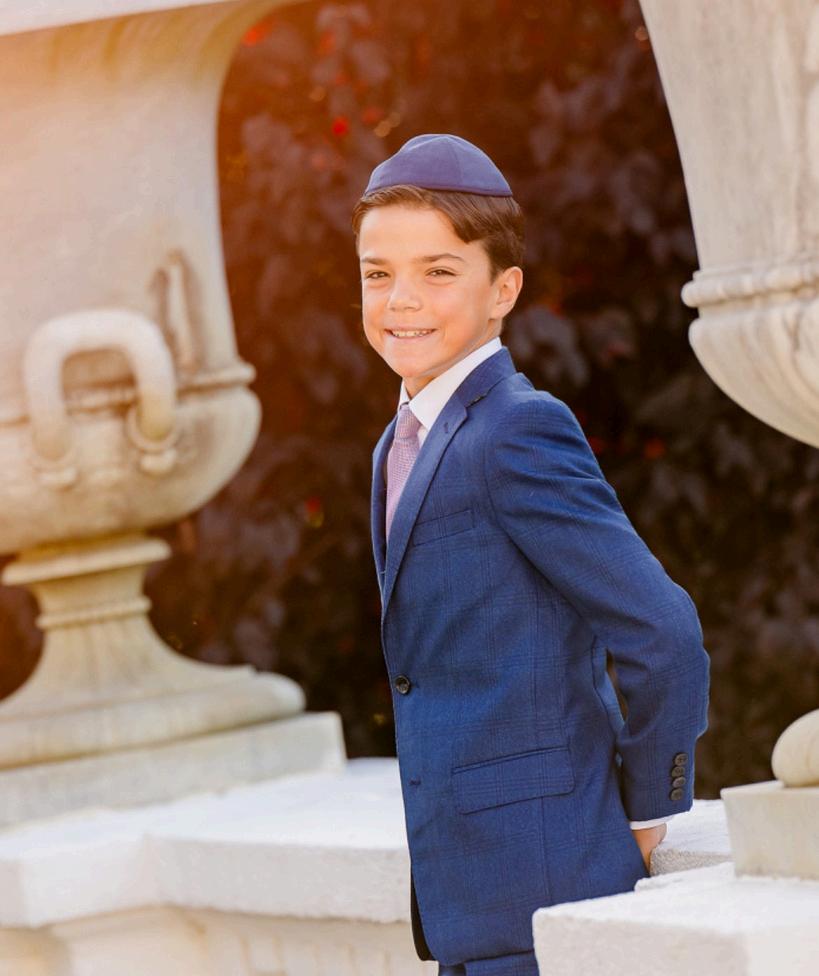
Garret Kule
Mazal Tov to Melanie and Andrew Kule upon the Bar Mitzvah of their son, Garrett, on Thursday, August 22, at Chabad of the Shore in Long Branch, NJ, at which time he read from Parashat Eikev. Garrett is a seventh-grade student at the Ramaz Middle School.
engagements
Karine and Eric Attias upon the engagement of their daughter, Noa, to Nate Fessel (Ramaz ’15), sonofMarkandSherryFessel.
Suzy and the late Sandy (z ”l) Eisenstat upon the engagement of their granddaughter, Anna Eisenstat, daughter of Dr. Jennifer Bursky Eisenstat (Ramaz ’89)& Jackie Eisenstat (Ramaz ’89)ofEfrat,Israel,toHayyimRimerman,theson of Claudia Kraut and Howard Rimerman of Ridgefield,CT.
SidneyandWendyIngberupontheengagementof theirgranddaughter,EvaRoseIngber,daughterof Rebekah and Adam Ingber of White Plains, to Sammy Merkin, son of Sharon and Sol Merkin of Englewood.
Ruth and Larry Kobrin upon the engagement of their granddaughter, Naama Kobrin, daughter of Michelle and Rabbi Jeffrey Kobrin, to Romi Harcsztark, son of Rivka and Rabbi Tully HarcsztarkofTeaneck.
Jackie Leifert and Saul Bodenheimer upon the engagementoftheirson,AryehLeifert(thesonof RobertJ.Leifertz"l),toYacovaColishGuigui.
Gabrielle Robertson and Solly Behar, who pray in theSephardicMinyan,upontheirengagement
Dr. Steven Rudolph and Naomi Ickovitz upon the engagementoftheirdaughter,Dina,toRabbiDan Katz,sonofEliKatzandJodiKatz.
Diane & Russell Miller and Marc Schwartzberg upon the engagement of their daughter, Julie Schwartzberg, to Jason Fruchter, son of Amy and PhilFruchterofFarRockaway.
May their weddings take place in happiness and blessing.
Nancy and Benjamin Aryeh upon the marriage of their son, Andrew, to Carole Menashe, daughter of Rebecca Menashe Betesh of New YorkandJackMenasheofDeal,NewJersey.
Dr. Taryn Fishman and David Bolnick upon the marriage of their daughter, Sarah, to Tom Moriarty, son of Elizabeth Philipp and Pat Moriarty,oftheUpperEastSide.
Vivian and Joshua Kestenbaum upon the marriage of their daughter, Sabrina Kestenbaum,toShaiHassan,inTelAviv
Robin Muss upon the marriage of her son, ZacharyAbada,toMichelleAboodi,daughterof Karen Silvera of Tenafly, NJ, and David Aboodi of Aspen, Colorado. Mazal Tov as well to the proud KJ grandparents, Harriet and Joshua Muss.

DianeandMickeyMarkovitzuponthemarriage inIsraeloftheirdaughter,SamanthaSharon,to Jonathan Adler, son of Dina and Jerry Adler of Toronto. Mazal Tov as well to proud KJ grandparentsFranandArnoldLederman.
May the newlywed couples be blessed to build homes faithful to the traditions of the Jewish people
Congratulations to Diane and Hon. Robert Abrams upon the publication of Diane’ s new book My Grandmother’ s Candlesticks, Judaism and Feminism: a Multigenerational Memoir. Spanning seven generations, three continents, as well as cultural, political, and technological revolutions, this captivating multigenerational memoir tells the story of one family’ s struggle to maintain its faith and to retain its traditions. Assimilation, women ’ s equality, and resurgence of Antisemitism are interwoven major themes. Available for purchase on Amazon.
Congratulations to Fran Brown, a 35+ year advocate for people with disabilities, for inspiring her youngest son, Daniel Brown, to follow in her footsteps as the dedicated Pro Bono Partner at a major American law firm specializing in litigation. Visit link.law.com/public/36617472 to learn about 3 major victories that Daniel’ s team secured in landmark cases brought on behalf of people with disabilities.
Congratulations to Bernice and Dr. Gilbert N. Kahn upon Bernice’ s family being the subject of a forthcoming history lecture by Professor Stefanie Fischer at the Leo Baeck Institute, on Jewish Cattle Traders in Southern Germany prior to World War II. Bernice’ s maiden name is Berman, and the lecture delves into her family’ s extensive engagement in this enterprise. Visit www.lbi.org/events/book-talk-cattle-traders for details.
Congratulations to Jamie Lassner’ s “Accessibility Accelerator” charity upon The Association for the Rights of Patients in Israel recognizing their Purple Vest Mission as the #1 provider of extraordinary care for patients since the war started on October 7 Their FIRST PLACE award commended Purple Vest Mission’ s “quick mobilization and work to help thousands of elderly and disabled people in times of emergency. ” Working non-stop since October 7, Jamie’ s Purple Vest Mission (arranged through “Access Israel,” their Israel-based collaborative partner) has provided hundreds of accessible evacuations while disseminating information, and humanitarian aid. Jamie’ s primary mission is hastening society’ s embrace of individuals with disabilities by accelerating the pace of access-enhancing improvements such as ramps, elevators and hands-free interfaces.
Congratulations to Mrs. Audrey Lookstein and the entire Lookstein family upon marking the dedication of the Audrey Lookstein Educational Innovation Center at the new AMIT Kfar Batya Campus in Ra’ anana, Israel. Mrs. Lookstein will be honored at the AMIT National Event on Monday, November 11th at Museum of Jewish Heritage. To honor Mrs. Lookstein and support AMIT, please visit amitchildren.org/2024event.
Congratulations to Dr. Michael Schulder upon receiving the Philip Gildenberg Award for contributions to stereotactic and functional neurosurgery at the recent conference of the World Society for Stereotactic and Functional Neurosurgery.
Congratulations to Ronit and Larry Schwab upon their daughter, Kelly, making Partner at the law firm of Chemtob Moss Forman & Beyda, LLP.
Eric Edell upon the passing of his grandmother, BeverleeEdell.
DavidEfronuponthepassingofhisfather,Herbert Efron
Caryl Englander upon the passing of her mother, RhodaJeanSchechter
SarahGlattandRobinGreenfielduponthepassingof theirmother,LindaKatz.
EricLewisuponthepassingofhisfather,BarryLewis.
Raquel Oppenheim upon the passing of her sister, MiriamBar-LevSugarman
Dr Bruce Taragin upon the passing of his father, Dr JoshuaTaragin
AproudKJMemberfor40years,Josephandhisbrother,Harvey,werethe“DynamicDuo”oftheUpperEast Side,involvedandactiveinthebustleofMetropolis.JosephtreasuredholidaysatKJ,sittinginthefrontpewin order not to miss clergy presentations. Ever curious about KJ goings-on, he insisted on paying his annual membershipduesinpersontoguaranteeanaudiencewithourstaffwhoprovidedinsightsintotherunningofa top-shelfcongregation.Josephwasatalentedartistandhumoristwhosewittycartoonsweremodeledafterthe iconiclampooningofTheNewYorkermagazine.Hisinsightsintohumannaturewereastute,revealinghisloveof observationandofpeople.Ourworldisdiminishedbyhispassing.
DevoraBrickmanjoinedourcongregationtwenty-twoyearsagowhensheandherlatehusband,RabbiSeymour Brickman, a wonderful Jewish educator and spiritual leader, moved to our neighborhood from Brooklyn, and honoredusbybecominganintegralpartofourKJfamily ShewasagraduateoftheYeshivaofCrownHeights andYeshivaUniversityHighSchoolforGirls,bothofwhichsheattendedasaclassmateofAudreyLookstein. Theyremainedclosefriendsforovereightyyears.DevoraandSeymourweretheparentsofthreechildrenand manygrandchildrenandgreatgrandchildren,allofwhomwereyeshivatrained ThreeofthemareRamazalumni
Devorahadanever-present,glorioussmileonherface.Itbespokealoveforthepersonshewasfacing,apositive attitude toward life under all circumstances and an inner happiness that inspired everyone whom she greeted. Everyone loved Devora, and for good reason. She was the most warm, caring and loving person. The most frequent word on her lips was “darling” It seems that everyone was her darling It was only natural that she herselfwaseveryone’sdarling.WhataremarkableJewishlady!
Natalio
BorninBuenosAires,Argentina,toparentswholeftPolandimmediatelybeforeWorldWarII,NatalioFridman became a distinguished “Balabos” here in America, serving on the Board of Trustees of both the Fifth Avenue SynagogueandKJ.
He and his beloved wife, Anne, a Ramaz alumna, shepped great nachas from their children David (and Gabby) and their grandchildren, Morrie, Flora and Mila. The grandchildren are all students at Ramaz; David is an active alumnusofRamazandGabbyisthecurrentPresidentoftheRamazParentsCouncil Allofthisisareflectionof themodelthatNataliosetforthemandtheexemplaryJewishlifethatheled.
A generous supporter of many Jewish causes, Natalio’ s specialty was Jewish education He was extremely generoustoRamazandtoKJ.HeservedasthePresidentofAmericanFriendsofArielInstituteswhosefounder, RabbiShearYashuvCohen,thelateChiefRabbiofHaifa,wasaclosefriend
Natalio was beloved by many friends and admirers who saw in him kindness, nobility and sweetness, highlighted by the ever-present smile on his face. He was particularly blessed by the love and care of his family and, most remarkably, by the devotion and inspiration of Anne, whose loving care for him added many years of productive andbeautifullifeforthisremarkable,Torah-loving,Jewishgentleman.

gation Kehilath Jeshurun warmly welcomes the following new members who joined ngregation between the printing of the last Bulletin on August 30, and this Bulletin, ent to press on September 26:
Apfelbaum
& Andrew Aryeh
& Brandon Aryeh
& David Berkowitz
& Jonathan Berkowitz
th Sondler-Bazar & Salomon Blutreich
& Jared Brecher
ernell & Frank Adam
& Thomas Furst
tha Sterling & Jonathan Gol
lton
aboulova & Maurice Kaufman
dra & Sean Lefkovits
n & Joe Nahmad
& Matthew Platt
Galapo & Elliot Schubin
& Alexander Shimoff
Stauber & Joseph Stern
Katz Tal & Tomer Tal
& Edward Weiss
& Josh Yashar
& Joshua Zabl
GreatsynagogueslikeKJaregreatinpartbecauseofthesupportthatthey receivefromthecommunitiestheyserve,andwehopeyouwilljoinother dedicatedpeopleinourcommunitybyconsideringKJMembership.Visit ckj.org/membershiporscantheQRcodeontheleftformoreinformation.
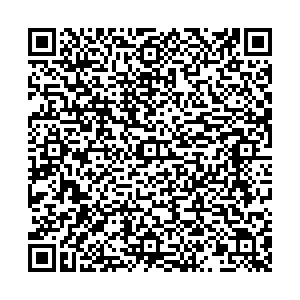




WearedelightedtoannouncethataftermanyyearsofrunningKJBL,KJ' s premierebasketballleagueforourcommunity'schildren,wearenowpartnering withFastbreakSportstoprofessionalizethisvaluablecommunityservice.
YoumayknowFastbreakSportsasapopularoptionforyoungathletesonthe UpperEastSide,andwearethrilledtobeofferingwell-pricedclassesinconcert withthemonSundaymorningsforboysandgirlsinGrades1-4(thesewillbesplit byageandgender).KJmemberswillreceivepriorityregistrationaswellasa discountpricethatmakesthisopportunitythemostaffordableoptioninthe neighborhoodTosignup,pleasescantheQRcodeattheleft,withKJMember discount"Kjmember" .
Weareexcitedtocontinueofferingthisdelightfulextracurricularopportunity andwelcomeanyfeedbackyoumayhave.
Date Weekly Parasha
Sep 27-28
Oct 4-5
Oct 18-19
Nov 1-2
Nov 8-9
Nov 15-16
Nov 22-23
Nov 29-30
Dec 6-7
Dec 13-14
Dec 20-21
Dec 27-28
Shabbat Shuva / Ha’azinu
Shabbat Chol Hamoed Sukkot
Rosh Chodesh Cheshvan / Noach
Lech Lecha
Vayera
Chayei Sara
Shabbat Mevarchim / Toldot
Vayetzei
Vayishlach
Vayeshev
Chanukah / Mevarchim / Miketz
DAtes to remember
Thursday&Friday,October3&4
RoshHashanah(scheduleonpage24)
Sunday,October6
TzomGedaliah
8AMMorningServices
Shabbat,October11-12
YomKippur(scheduleonpage24)
Thursday&Friday,October17&18
Sukkot (scheduleonpage35)
Shabbat-Tuesday,October19-22 CholhaMoedSukkot
Wednesday,October23
HoshanahRabbah

Thursday,October24
SheminiAtzeret (scheduleonpage36)
Friday,October25
SimchatTorah (scheduleonpage36) 9:15AMWomen’sTefillah
Friday&Shabbat,November1&2 RoshChodeshCheshvan
Tuesday,November5
ElectionDay
Thursday,November7
7:30PMKristallnachtProgram
Thursday,November28
Thanksgiving 8:30AMMorningServices Shabbat
6:30AMMorningServices

